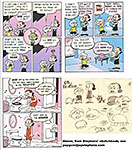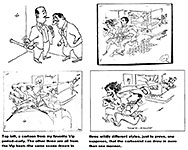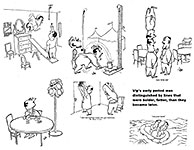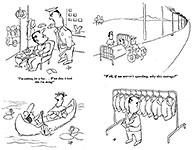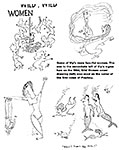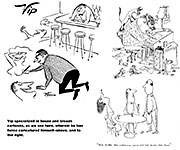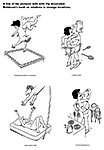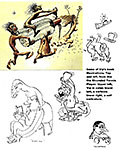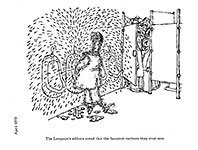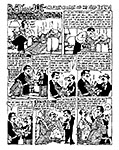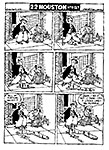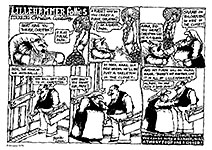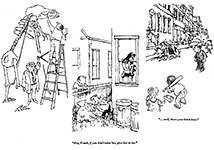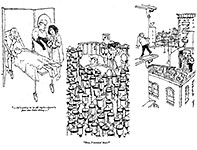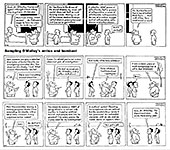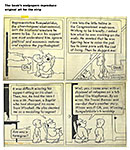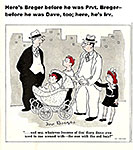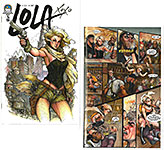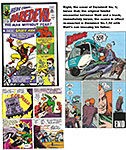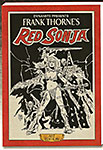 |
||||||||||||||||||||||
Opus 324 (May 27 2014). Down the rabbit hole this time, we encounter April, the cruelest month, crammed with racism in its several insidious albeit ugly manifestations, and we take a long look at how editoonists treated these and other timely events. We also report the winners of the Pulitzer and several other awards, recognize the 50th anniversary of the Fold-In, list the most often censored books, review Killing Jesus and reprint tomes of cartoons by two of the best single-panel cartoonists in history—Vip and Charles Rodrigues, applaud what may be an adult outcome to the childish punishment being contemplated in South Carolina because a state college put Fun Home on its reading list, and say a lingering fond adieu to comics workhorse Dick Ayers and Al Feldstein, who, in death, is finally given the recognition he has so long deserved. And more—much more, including paintings by modern masters GeeDubya and RCH and my campaign to destroy the National Rambo Association. In short, a lot. More than usual. Our natural tendency to prolixity is given free rein in the digital ether with disastrous results, as you can readily attest. Length. Verbosity. More and less frequent than we promised. The postings, as you may have noticed, are coming half as often but are twice as long to make up for it. But we acknowledge and admit our garrulousness and even arrange for your possible comfort in confronting it. The listing of the contents of this posting that follows this preamble immediately is expressly designed to enable you to avoid long boring disquisitions—and/or topics—that don’t interest you. Rather than attempting to read this entire elephantine opus, scan the contents and pick the parts that interest you; then scroll quick like a bunny through the whole mess, pausing only when you get to subjects of interest. Here’s what’s here, by department, in order—:
NOUS R US Comic-Con Surge DooneSite Aged Spiked Doonesbury Ted Rall Finds a Job Derf’s City Over? Or Not Boondocks Without McGruder Neiman on Baseballs Cartoonists of the Apocalypse Fails to Fund Finger Family Disputes DC Playboy’s Child Pornography Fifty Years of Folding-In Anniversaries: Shakespeare and Tarzan Harvey’s Baker’s Dozen
AWARDS SEASON: Part Two Pulitzer for Kevin Siers Finalists: Pat Bagley and David Horsey Fun Home Musical, Runner-Up in Drama KAL Gets Nasty Woodring Gets Ward Prize Harry Bliss Gets Five Weeks in Sendak Country Sorensen Wins SDX Award
Compromise Possible in Fun Home Kerfuffle
INCOME INEQUALITY EXAMINED
EDITOONERY The Month of Racism in Cartoons Racism Discussed O’Reilly’s Killing Jesus Refuted The End of Climate Change Political Religion
The Froth Estate Newspapers Declining/Increasing in Circulation, Revenue
GeeDubya Becomes Painter Harvey, Too (Visuals Galore)
NEWSPAPER COMICS PAGE VIGIL Taboos Violated and Other Shenanigans in the Funnies Best Drawn New Comic Strip: Oh, Brother! at GoComics
CENSORSHIP Bone Makes the List of Most Challenged Books Reports from CBLDF and the National Council of Teachers of English
BOOK MARQUEE: Short Reviews Vip: The Mad World of Virgil Partch The Complete Peanuts, Vol. 21 (of 25) Graphic Novel Coming from Scott McCloud The Complete Cul de Sac
BOOK REVIEWS: Longer Reviews Ray and Joe: The Story of a Man and His Dead Friend Barnaby: Volume One, 1942-43
Collector’s Corniche Pre-war Breger
MY CAMPAIGN TO DESTROY NRA
FUNNYBOOK FAN FARE Lola XOXO Daredevil’s 50th Frank Thorne’s Red Sonja ONWARD, THE SPREADING PUNDITRY Statistics on Justice and the War on Poverty Political Spending in Tea Cups Hate Groups
PASSIN’ THROUGH Al Feldstein, 1925-2014 Dick Ayers, 1924-2014
Our Motto: It takes all kinds. Live and let live. Wear glasses if you need ’em. But it’s hard to live by this axiom in the Age of Tea Baggers, so we’ve added another motto:.
Seven days without comics makes one weak. (You can’t have too many mottos.)
And our customary reminder: don’t forget to activate the “Bathroom Button” by clicking on the “print friendly version” so you can print off a copy of just this installment for reading later, at your leisure while enthroned. Without further adieu, then, here we go—:
NOUS R US Some of All the News That Gives Us Fits THE 2014 PULITZER PRIZE for editorial cartooning was awarded to Kevin Siers of the Charlotte Observer. The prize committee praised his work as “thought provoking.” Finalists are David Horsey of the Los Angeles Times and Pat Bagley of the Salt Like Tribune. A more prolix report on these cartoonists appears at the end of this Nous Section.
THE COMIC-CON SURGE In its second year on April 18-20, Washington, D.C.’s Awesome Comic Con grew 250%, from last year’s 7,000 participants to this year’s 40,000. This overwhelming growth may be attributed to Kickstarting $56,000 that organizers used to reserve larger space at the Walter E. Washington Convention Center and for promotion. While the event was rich in cosplayers, big publishing players—Marvel, DC, Dark Horse, Image—had no “real or official presence,” reported Hashim Hathaway at bleedingcool.com On the same weekend in Salt Lake City, reports Alan Gardner at Daily Cartoonist, the inaugural Salt Lake Comic Con FanXperience (FanX) attracted over 100,000 attendees. “A sister Con to the Comic Con that started last summer, the event was more geared toward connecting fans with entertainment celebrities, but it was still a comic con,” said Gardner. Gardner goes on to quote Bryan Brandenburg, Salt Lake Comic Con Co-founder and VP of Marketing: “The fact that we exceeded attendance expectations proves that Salt Lake City is a focal point for Comic Con and pop culture and is further proof to the comic con world that Salt Lake is a major player in the industry. The increased success will serve as evidence moving forward that will attract celebrities, vendors and production companies, which in turn will help increase the overall fan experience as well as the visibility of Salt Lake Comic Con and Utah in general. Our aim is to offer a complementary convention to the annual San Diego Comic-Con International.” Noting that he has no financial interest in promoting this event other than to strengthen it locally, Gardner adds that tickets go on sale next month for the larger Salt Lake Comic Con slated for September 4-6, 2014. Next month over Father’s Day weekend, June 13-15, the Denver Comic Con will convene for the third year. Last year, attendance soared beyond the previous year’s. Maybe again this year. Unlike Gardner, I have a financial interest in promoting the Denver Con: I’ll be there, in “Artists Valley” (between the peeks), selling books and drawing caricatures.
ODDS & ADDENDA Advance orders for the first issue of the re-launched Amazing Spider-Man No.1, which features the return of Peter Parker who “died” last year in Amazing Spider-Man No.700, topped 500,000 saith Marvel. ... The Easter Sunday edition of Parade resurrected the Cartoon Parade feature with two (count ’em two) cartoons—by Harley Schwadron and Rina Piccolo. Dunno what, if anything, this bodes for the future. The next week, we were down to one cartoon—en route, no doubt, to none, as has been the prevailing mode, which resumed, alas, on May 18. Chester Gould’s daughter and other guardians of Dick Tracy memorabilia have donated it all to the Billy Ireland Cartoon Library & Museum at Ohio State University in Columbus, Ohio. The collection, which includes more than 850 original daily Dick Tracy strips (among them, the first 30 days of the strip), 64 Sunday strips, and Gould’s drawing board upon which Gould created the strip for 46 years, will be catalogued and made available to students and scholars, just as the rest of the BICL&M holdings are. All these items had been displayed at Woodstock, Illinois (near Gould’s home), in the historic Courthouse on the Square until the town could no longer afford to give up the space.
DOONESITE & MORE Doonesbury.com, the “ultimate destination for fans of Garry Trudeau’s famous comic strip,” has moved from Slate to the Washington Post’s website, the Post announced. It seems like a good place to go for a Doonesfix now that the daily strip is in reruns while on indefinite hiatus: at the new location, fans can find a good deal more than just vintage strips. According to the Post’s announcement—: More than just your average fan site, Doonesbury.com is a place where readers can interact with the strip and its characters through fresh content and features like daily videos, links to news stories, a regular Straw Poll, character bios, a Doonesbury timeline and more. Other regular features exclusive to the site include: Blowback: A moderated forum of interesting
comments on the strip from readers around the world. Readers can also access the full archive of past Doonesbury strips. The site can be found at doonesbury.washingtonpost.com
Incidentally... The week of
April 21, the Washington Post finally printed the controversial Doonesbury strip that the paper had spiked 41 years ago. In the strip itself, radio host Mark Slackmeyer, delivering a mock ‘political obituary,” rehearses John Mitchell’s role in the nefarious Watergate scandal. The Post published it in April as part of the Doonesbury recycling that is taking place from sea to shining sea while cartoonist Trudeau puts the strip on indefinite hiatus in order to pursue his new career as the author of the satirical tv political sitcom “Alpha House.” On the Amazon channel. The 1973 Doonesbury killing was the first time that the strip had been killed by a client newspaper; and the Post wasn’t alone: more than a dozen of the 300 or so papers running the strip spiked this installment. “It was a very big deal for me at the time,” Trudeau told Cavna. “I’d never been booted from so many papers at once, and the Post was such a surprise.” In an editorial, Robert C. Maynard explained the Post’s rationale, quoting managing editor Howard Simons: ““If anyone is going to find any defendant guilty, it’s going to be the due process of justice, not a comic strip artist. We cannot have one standard for the news pages and another for the comics.” Maynard concluded that there is a line “across which responsible expression cannot step without running the risk of excision. Trudeau, in my opinion, stepped across that line in having Mark speak as he did.” At the Boston Globe, which also murdered that day’s strip, editor Tom Winship said: “It’s a beautiful strip, but I have no trouble with this decision.” And a Los Angeles Times executive was quoted in news stories as saying his paper did not run the strip because it “in effect convicts John Mitchell.” Reaction was immediate. The Post got at least “500 telephone calls from disappointed readers, wanting to know what had become of Doonesbury, ” Maynard reported. (The Globe and the Baltimore Sun also received enough complaints that editors said Doonesbury news items would be warranted.) Then letters arrived. Wrote Bonnie Westley of Gaithersburg, in part, in reaction to Maynard’s editorial: “It amazes me that an intelligent and sophisticated man can come up with such a flimsy excuse for censorship.” And Alice Omohundro of Washington wrote: “As has been pointed out, a newspaper is not bound by the same procedures as a court of law. Therefore, it seems to me that the Post was totally unjustified in refusing to extend to Doonesbury the same rights it claims for itself.” Trudeau’s reaction at the time: “My highest priority is entertainment. I wasn’t saying John Mitchell was guilty. It was a parody on all the people who are over-reacting.” (In other words: Some editors may have wrongly interpreted Slackmeyer the character as being a pure and literal mouthpiece for Trudeau’s own feelings.) Two years later, Trudeau would win the Pulitzer Prize for his Watergate commentary — including his “stonewalling White House” strips — making Doonesbury (its profile raised by each news article about such controversies, which became more and more numerous) the first comic strip ever to win the editorial cartooning prize. And two years after that, Mitchell — found to be guilty — would begin serving a 19-month prison sentence. (Mitchell died in 1988, and was buried at Arlington National Cemetery.) All of which proves that Maynard was right about one thing he said in his notorious editorial: “Doonesbury’s well-earned popularity is based on the pithy way in which its characters sink their teeth into contemporary subjects. The strip is created with a sure-handed sophistication that is pointed even when it isn’t funny.”
TED RALL FINDS WORK Political cartooning’s most vociferous gadfly and pain in the tukus, Ted Rall, has, after decades of walking the high wire of freelancing, found a job. He posted the news at his website: Pando Daily, a web publication that offers technology news, analysis, and commentary, with a focus on Silicon Valley, has hired me as a full-time staff cartoonist and writer. I will be drawing editorial cartoons, spot illustrations and comix journalism, as well as writing both short-form as well as feature-length commentary and journalism about politics, tech and the intersection between politics and tech — in other words, tech as politics. Whatever feels smart and right; we’ll do it. This is exciting. Having witnessed the disintegration of print media since before there was an Internet, mostly due to terrible management decisions, I’m thrilled to join a news organization that is forward-looking, gutsy and smart. It says a lot about Pando’s understanding of the value of visual media that, while newspapers and magazines fire cartoonists, they’re hiring them. [One at least.] This will be my first full-time job as a cartoonist, and I couldn’t be happier. Editorial cartooning has been dying/getting killed, so my hiring — coupled with that of Matt Bors at Medium last year — points to a possible way out of the print newspaper trap. Lots of websites that can obviously afford to hire writers — Salon, Slate, HuffPo, etc. — can easily afford to take on cartoonists—and they should, because cartoons are popular online, and provide a type of commentary no other medium can replicate. All you have to do to see that this is a good fit is to spend a few minutes reading stories at Pando. They do what I care about: go after the truth, and kick ass. If you’re a fan of my syndicated political cartoons and columns, don’t worry — those will go on. I will also continue my cartoons and blog for The Los Angeles Times. I will continue to work on new book projects, including international conflict reporting. [Congrats, Ted.]
IS THE CITY OVER? At his derfcity.blogspot.com on May 15, Derf Backderf announced that he was ending his comic strip The City —after 24 years—in order to concentrate on making graphic novels, a forte he has only recently discovered in the success of My Friend Dahmer and Trashed: “Bottom line is I’d rather make books and the truth is, I’m a lot better at graphic novels than I ever was at a comic strip. It’s obviously what I should have been doing all along. To paraphrase Elvis Costello, ‘I’m an overnight sensation—after 30 years.’” The report, straight from the horse’s mouth though it is, is not exactly accurate. Derf’s own announcement is subject to wild misinterpretation. Turns out there are two versions of The City—a local, Cleveland, version and a national version. My spies tell me that only the Cleveland version is ending. The national version will continue, it seems. From Derf (alledgedly): " Just to clarify: only my Cleveland version (which was the original version) of The City is ending. I’ll continue with a national version, which appears in 15 or so weekly papers and online at Gocomics.com for now." But this clarification has yet to appear in the blog that announced the demise of The City. So who knows? In announcing the Cleveland version’s death, Derf expounded on his 24-year career and related matters—: “By my count, I've produced over 1,500 strips. That includes strips that only ran here in Clevo. The City has appeared in 174 publications during it’s life, mostly weeklies such as The Chicago Reader, The NY Press, The LA Reader, Miami New Times, and The Cleveland Free Times. The City outlived three of those five papers, which tells you all you need to know about the state of the weekly press. I am grateful to each and every one (except, of course, to the rags that I had to cut off for non-payment). It was a great run and we all did wonderful and important work together. I am proud to have been part of it, but it's a real bummer to be hitched to a dying industry. I've been a passionate newspaperman for 30 years, stretching all the way back to my days as a cartoonist (and journalism major) for the Ohio State Lantern. Enough. I have a much better option.”
BOONDOCKS BACK WITHOUT McGRUDER After a 4-year hiatus, Aaron McGruder’s “The Boondocks” is returning to Adult Swim television for a fourth season but without its creator, who also created the newspaper comic strip upon which the animated tv show was based. McGruder commented publicly on his departure only through press releases and official posts on the Facebook page of his new show “Black Jesus,” reported Rich Goldstein at thedailybeast.com. On March 16, McGruder posted this: “Just found out someone has hijacked The Boondocks Facebook page. This was done without my permission and I have absolutely no control over the content being posted as of Friday, March 14.” Then on March 27 McGruder posted the following statement (in italics): As the world now knows, “The Boondocks” will be returning for a fourth season, but I will not be returning with it. I’d like to extend my gratitude to Sony and Adult Swim for three great seasons. I created The Boondocks two decades ago in college, did the daily comic for six years, and was showrunner on the animated series for the first three seasons. The Boondocks pretty much represents my life’s work to this point. Huey and Riley Freeman and their Granddad are not just property to me. They are my fictional blood relatives. Nothing is more painful than to leave them behind. To quote a great white man, “Hollywood is a business.” And to quote another great white man, “Don’t hold grudges.” What has never been lost on me is the enormous responsibility that came with The Boondocks—particularly the television show and its relatively young audience. It was important to offend, but equally important to offend for the right reasons. For three seasons I personally navigated this show through the minefields of controversy. It was not perfect. And it definitely was not quick. But it was always done with a keen sense of duty, history, culture, and love. Anything less would have been simply unacceptable. As for me, I’m finally putting a life of controversy and trouble-making behind me with my upcoming Adult Swim show, “Black Jesus.” Goldstein continues: McGruder’s absence from the fourth season of “The Boondocks” is a sore point for fans of the show, but if anyone is equipped to explain the pain and loss it is unironically Aaron McGruder. In the first year of the comic strip’s syndication, he told Baltimore’s CityPaper.com, “This is a strange job. The combination of talents that you need to be a daily cartoonist is weird. And we are weirdos. Charles Schulz has this really dark streak that comes out in Peanuts ... Lynn Johnston talks about dealing with depression. [Calvin and Hobbes creator] Bill Watterson is up in a cabin somewhere. And I have my own head stuff. Doing this day in and day out is hard.” The comparison to Watterson and Schulz is particularly poignant given each creator’s approach to media rights. Watterson never authorized his characters for reproduction in other media, and yet the place most people see Calvin these days is stuck to the back windows of trucks peeing on things. And as for Schulz, last Christmas ABC aired the Charlie Brown special for the 40th year, not shown were the lesser known cartoons produced direct-to-video after Schulz’s death. [Being a blithely ignorant old gaffer, I don’t know about any of these and, in fact, doubt that there are any.] Unlike those post-Schulz Peanuts, McGruder has not disappeared. He will return in Adult Swim’s “Black Jesus,” which Boondocks fans will recognize as the title of Boondocks protagonist Huey Freeman’s play from Season 1. That show received a “twenty minute standing ovation” and was called “a stunning revolution in theater” by the completely unbiased Woodcrest Post Gazette. This incarnation of Black Jesus is live action and features a modern day Christ, complete with apostles, healing the sick and the lame on the pavement of Compton, California. Concludes Goldstein: The real Jesus, if he existed at all, only preached for about two years before he was crucified by Rome. Aaron McGruder's The Boondocks has been around for almost 20 and it's come back from the dead more than once. And besides, what is walking on water and feeding the masses some meager loaves and fishes besides parlor magic and Judaic frugality. But getting a show with an all-black cast on American television? That's some kind of miracle.
BASEBALL ART LeRoy Neiman, famed for the Femlin he created for Playboy magazine, also drew on baseballs. He drew Babe Ruth on one and Mickey Mantle on another and over a hundred more—all as personal gifts to a friend, Charlie McCabe. Neiman, “celebrated for evoking the kinetic energy of sporting events,” said Ula Ilnytzky at the Associated Press, “was the official painter of five Olympiads.” Altogether, he drew on 129 baseballs, which McCabe sold at a Heritage Auctions online sale recently. Said McCabe: “The first ball LeRoy made would have been 1978, when we went to Mets spring training. I gave him a ball and asked him to draw on it. He got a real kick out of painting the baseballs because he hadn’t ever drawn anything on a ball before.” Neiman usually drew with color magic markers. Over the years, McCabe asked Neiman to draw other celebrities on baseballs. Many of the balls, if not all, are signed by the persons depicted. “A special piece is a 1992 ball of Marilyn Monroe that is signed ‘To Charlie, Best wishes, Joe DiMaggio.’ What makes the ball rare is that DiMaggio, who was briefly married to the actress, famously refused to sign anything related to her.”
CROWD-FUNDING FOUR CARTOONISTS OF THE APOCALYPSE Ted Rall and three other iconoclastic cartoonists—Scott Stantis, Stephanie McMillan and Stephen Notely—have been drumming up paying subscribers for their apocalyptic feature at Beacon Reader. The idea was to provide subscribers with original art and backstage glimpses of the editoonists at work. It was to be a “no holds barred online publication,” Rall said. “We don’t agree about anything, and our work’s very different. But we have a mutual respect fore ach other’s work, intelligence and humor.” They needed 400 subscribers, each paying $5 or $10 a month. Intriguing idea, but it fizzled at 80 subscribers.
GETTING FINGER RIGHT (May 7, 2014) The Comics Arts Council sent out a press release late last night detailing how the Finger Estate definitely does not agree with a DC representative’s remark that the comics company was “all good” with Finger and his family. Here’s the full press release—: During a recent WonderCon Anaheim panel for Batman’s 75th anniversary, an audience member asked panelists for opinions about the fact that writer Bill Finger does not get a creator credit alongside Bob Kane, who is credited as the legendary character’s sole creator even though Finger came up with defining qualities for this character before Kane ever signed his first contract to produce the Dark Knight’s adventures. Finger wrote the first Batman story, his tragic origin, and hundreds upon hundreds of comic book stories for more than a quarter of a century. He named both Bruce Wayne and Gotham City, he created Commissioner Gordon, he developed many other supporting characters, he created or co-created one fantastic villain after another, and yet he died broke and relatively unknown more than 40 years ago. After a moment of silence following the audience member’s question, panelist Brian Buccellato joked, “Crickets.” The panel’s moderator, DC Comics’ Larry Ganem, then said: “We cherish what Bill Finger did and his contribution to creating Batman, and we’re all good with Finger and his family.” The aforementioned Finger family, which consists only of Bill Finger’s granddaughter and her son, later learned about this exchange and did not agree with Ganem’s “all good” assessment. Athena Finger Responds: 75 years of Batman! No one could have predicted the longevity and the continued relevance of this comic book hero that has become a cultural icon when my grandfather, Bill Finger, collaborated with Bob Kane back in 1939. My grandfather has never been properly credited as the co-creator of Batman although was an open secret in the comic book industry and is widely known now. It is now my time to come out of the shadows and speak up and end 75 years of exploitation of my grandfather, whose biggest flaw was his inability to defend his extraordinary talent. Due to what I feel is continued mistreatment of a true artist, I am currently exploring our rights and considering how best to establish the recognition that my grandfather deserves. In his autobiography, Bob Kane acknowledged: “Now that my long-time friend and collaborator is gone, I must admit that Bill never received the fame and recognition he deserved. He was an unsung hero.” Regarding the issue of giving Finger official credit, Kane specifically said: “I often tell my wife, if I could go back fifteen years, before he died, I’d like to say, ‘I’ll put your name on it now. You deserve it.’” This fall, the Warner Bros. television series “Gotham” will feature many Bill Finger creations, including the city itself. Will the series that carries the name he gave to Batman’s city credit him in any way?
PLAYBOY’S CHILD PORNOGRAPHY The defoliated pudenda (or, in the vernacular of the saloon and locker room, “shaved beaver”) that has become de rigeur in Hugh Hefner’s magazine for some years now makes the mons veneris look like a little girl’s—ergo, child porn.
FIFTY YEARS OF FOLDING-IN Al Jaffee’s first Mad famed Fold-In was published in the magazine dated April 1964. Explaining his inspiration, Jaffee, quoted in the January-February issue of the National Cartoonists Society’s newspaper, The Cartoonist, said: “Playboy had a foldout of a beautiful woman in eash issue, and Life had these large, striking foldouts in which they’d show how the earth began or the solar system or something on that order—massive panorama. ... Many magazines were hopping on the bandwagon with similar full-page spreads. ... So I figured, why not reverse it? If other magazines are doing these big, full-color foldouts, well, cheap old Mad should go complete the opposite way and do an ultra-modest black-and-white ‘fold-in.’” Interviewed at thephoenix.com, Jaffee explained how he devised the first fold-in: “I thought to myself ... how it’s folded in and I’ve got to have something on the left side here and something on the right side here. And the only thing that popped into my head was that Elizabeth Taylor had just dumped Eddie Filsher and was carrying on with Richard Burton. So I had Elizabeth Taylor kissing Richard Burton, and a cop is holding the crowd back—and just for the fun of it, I put Eddie Fisher being trampled by the crowd. What a cruel thing to do! “And
then, when you fold it in, she’s moving on from Richard Bukrton and kissing the
next guy in the crowd. It’s so simplistic and silly and juvenile! And anyone
could have done that! “I showed it to Al Feldstein, and the first thing I said was, ‘Al, I’ve got this crazy idea, and you’re not going to buy it because it mutilates the magazine.’ So I put it in front of him, and the thing about Al was, he liked things that intrigued him. The mechanics of it intrigued him. He said, ‘You mean, you fold it, like this ...? And then...?’ He folded it, he unfolded it, he folded it, and then he said, ‘I like this.’” Feldstein checked with Mad publisher, Bill Gaines, because the Fold-In, if performed, would mutilate the magazine. And Gaines said: ‘So they mutilate the magazine, and then they’ll buy another one to save.” Four weeks later, Feldstein asked Jaffee what he was going to do for the next issue’s Fold-In. Jaffee, who thought one was enough, wracked his brain for another. And for the ensuing issue, another. And another and so on into the night. A masterpiece of comedic art had been born and it incestuously inbred again and again until it became a national institution. The whole magilla was published three years ago in The Mad Fold-In Collection 1964-2010, 842 pages, a four-volume slip-cased set, reproducing 410 Fold-Ins at their original size with digital representation of the folded image on the following page so collectors won’t have to fold their book’s pages to get the gag (originally $125 but now available through Amazon and elsewhere for considerably less; used copies at Amazon were going for $11 in mid-April).
ANNIVERSARIES It’s the 450th anniversary of William Shakespeare’s birth this year, in honor of which, The New Yorker published the portrait we’ve reproduced nearby, the
latest claimant as an authentic likeness of the Bard. It bears the date 1603,
when the playwright would have been 39 years old and famous for his plays since
about 1596, the year he also acquired a coat of arms, establishing himself as a It’s also the 100th anniversary of the first publication of Tarzan of the Apes. But we have no picture of him this time. Or of the apes. Use your imagination.
My Baker’s Dozen Do Not an Influential Make AS IT DOES
EVERY YEAR at about this time, Time magazine devoted an entire issue to
photographs and short blurbs about the “100 most influential people in the
world.” And again this year, for the 10th or 11th year in
a row, I’m humbled and exasperated to see that I’m not in this distinguished
ensemble. No telling why. It’s not as if I’m a complete no-account. I’ve
authored a dozen books over the years—written eight, cover to cover, and edited
another five. Eight of those titles are available (and fulsomely described)
right here on this website. The other five are: Cartoons of the Roaring
Twenties (3 volumes, although only two have been published by
Fantagraphics), The Life and Art of Murphy Anderson, and the rare and
out-of-print Not Just Another Pretty Face: The Confessions and This fall, we’ll reach pass beyond a baker’s dozen with Insider Histories of Cartooning: Rediscovering Forgotten Famous Comics and Their Creators. It will be available through the mechanisms of this website when the time comes. Perhaps, next year Time will correct the error in judgement that it has consistently made for as long as it’s been publishing its “influential people” issue. Then again, maybe not.
AWARDS SEASON: PART TWO The Pulitzer THE PULITZER PRIZE for editorial cartooning has been awarded to Kevin Siers, who, according to his newspaper, the Charlotte Observer, has punctured political windbags across the Carolinas with the soft tip of a paintbrush for the last quarter century . “And last week, I won a fishing contest, too,” Siers, 59, quipped to colleagues gathered in the newsroom to toast him when the award, which includes $10,000, was announced. “I’m in a cloud – it’s surreal,” he told ComicRiffs’ Michael Cavna. “It’s every cartoonist’s dream.” Observer editor Rick Thames called Siers one of Charlotte’s enviable civic distinctions. Said he: “Every day, Kevin lifts us above the contradictions in public life and calls out what really matters. He tweaks and pokes and, most importantly, says flat-out what others would have us try to read between the lines. As a bonus, we get to laugh and cry together.” Pulitzer
jurors, in one of the committee’s typically inane and vacuous remarks, said
Siers’s pen and watercolor-brush artworks offered “thought-provoking cartoons
drawn with a sharp wit and bold artistic style.” We could say that about almost any editorial cartoon. Why can’t this conclave of so-called experts on editoons say something about what makes this year’s winner’s work distinctive—or particularly worthy of the award? Having not seen much of Siers’ work, I can’t say. But didn’t the Pulitzer commitee see at least the 20 cartoons he submitted? More than I’ve seen. Siers himself has a better grip on what makes his work unique. His cartoons reflect angles from across the political spectrum – a bipartisan mixed bag, from Hillary Clinton to the NRA – though Siers classified himself to Cavna as “a very liberal cartoonist.” The portfolio he submitted, he said, “was really half and half,” noting that he got critical push-back from the NRA and Hillary Clinton supporters in 2013. “Half the cartoons go after Obama, and half go after conservatives. ... As a [political] cartoonist, I’m always trying to poke a stick into the spinning spokes.” For that metaphor alone, he deserves an award.
AS A CHILD GROWING UP in the rural Minnesota iron range about 60 miles north of Duluth, Siers (pronounced “Sires”) began drawing before he could spell, according to the Observer’s report on his winning (from which we poach the rest of this article almost verbatim). He would sketch cartoons, then draw gibberish in the bubbles he’d provided for the dialogue. Siers improved his skills by imitating the style of newspaper comic strips such as Pogo and Dick Tracy. By the fourth grade, he was copying the intricate fantasy artwork of Marvel Comics’ Spider Man and Fantastic Four. “I imitated everybody,” Siers said. “I stole left and right. Eventually, I came up with my own style.” After high school, Siers worked in the mines, starting as a laborer and working his way up in the mining hierarchy. It was well-paying work, and whenever he’d saved up enough, he’d take classes at the University of Minnesota in Minneapolis as a biology major, then return to the mines or other jobs to earn more. During one layoff at the mine, he submitted cartoons and got them published in the local weekly, the Biwabik Times. They went on to win a prize from the Minnesota Press Association. “So I said, I guess I could do this,” Siers said. Back at college, he began doing editorial cartoons for the campus newspaper, the Minnesota Daily. He got to know Steve Sack, political cartoonist for the Minneapolis Star Tribune and last year’s Pulitzer winner for editorial cartoons. “Sack was my mentor,” Siers said. “He’d take me out to lunch and show me grown-up cartoonist tricks.” After years of on-again, off-again enrollment, Siers finished at Minnesota in 1987 at the age of 33. He did freelance art work, which led to what he remembers as his most dreadful assignment. He was hired to fly to Orlando and draw caricatures of executives attending a banking convention. But the executives didn’t want caricatures and sent their wives instead. “So I was drawing caricatures of middle-age women. That was really uncomfortable. I didn’t know how to pretty them up. I wasn’t that good an artist yet. I was squirming, they were squirming. So, I guess I got used to making people uncomfortable there.” That fall, Siers landed a job at the Charlotte Observer, replacing cartoonist Doug Marlette, who had left for the Atlanta Constitution. He starts every day by studying the newspaper to get ideas. He then attends the morning editorial board meeting where topics are discussed for the Observer’s opinion page, but he’s under no obligation to adhere to the board’s opinions. Unlike most of his breed who have long since been drawing on the computer screen, Siers still uses the time-tested tools— a watercolor brush and fine-point pen. “I dip the water-color brush in India ink and the brush is responsive,” he said. “You push down and get a thick line. You ease up and you get a fine line. I’ve thought about using the computer, but I just love the physical feel of pushing against the paper. It’s very hard to let that go.” At the end, he scans the finished cartoon into the computer, and uses a Photoshop program to colorize it. He sends copies of cartoons on national issues to King Features Syndicate, which distributes them to clients across the country. As is the case with most editorial cartoonists, the victims of Siers’ ridicule are enamored of his work—particularly when they are the subject. The late Senator Jesse Helms was among those who have requested and received originals of cartoons in which they have been lanced by Siers. “Jesse used to have a wall of editorial cartoons about him in his office,” said Siers. “He used them to raise campaign contributions – he’d say, ‘See what they're doing to me. Send money!’ ” Siers is the last full-time daily newspaper staff cartoonist in the Carolinas. “I’m just really grateful to still be working and lucky to be at one of the the papers that still values editorial cartoons,” Siers said. He said he believes economics is only part of the reason many newspapers have abandoned local editorial artists. Some of them, he said, don't want the hassle that a cartoonist can stir up. “A lot of newspapers don't want a strong voice in the community,” Siers said. More than half of his cartoons are on local or state issues, rather than national politics. Observer publisher Ann Caulkins said she couldn’t imagine the paper without the punch of an editorial cartoonist. “And we’ll have one,” she said, “as long as I’m here.”
Pulitzer Finalist Pat Bagley. “He’s something like a soothsayer and a weather vane, pundit and funnyman all rolled into one,” wrote Christopher Smart, a fellow staffer at the Salt Lake Tribune. The Pulitzer jury was, typically, a little less precise, opting, instead, for a description of Bagley’s work that could be applied to virtually any successful editoonist’s oeuvre: Bagley’s work stood out, the committee said, “for his adroit use of images and words that cut to the core of often emotional issues for his readership.” “For the past 36 years,” Smart went on, “Bagley has been skewering the powerful and intemperate, while bringing wry smiles to Tribune readers of all stripes.” Continuing from Smart’s article—: The 58-year-old Bagley has drawn more than 10,000 cartoons for the Tribune. “I wake up in the morning and I’m grateful I get to do this, because I love my job,” he said. “Every day is a high-wire act. Some days I get the idea [for a cartoon] early. Other days I’m pushing deadline. It’s different every single day.” Bagley often takes aim at Utah politicians. And since the state Legislature is dominated by Republicans, they usually catch his flak. Although many Utahns can’t wait for the annual 45-day state legislative session to end, Bagley savors it: “When the Legislature is in session, being a cartoonist is the easiest job in the world,” he said. “They write the material for me.” Bagley was born in Utah but grew up in California and comes from a long line of Utah Mormons. Nonetheless, a frequent target of his pen is The Church of Jesus Christ of Latter-day Saints. A recent cartoon had two men looking out a widow in the Church Office Building staring down at the Salt Lake LDS Temple with the Utah Capitol in the background. One remarked to the other: “Do other religions have their very own Legislatures?” “I’m not hostile to the church,” said Bagley, who calls himself a Mormon Emeritus. “But they are a huge presence — they are the 800-pound gorilla [in Utah]. I wouldn’t be doing my job if it didn’t [include them].” One of the many Utah politicians who has been on the receiving end of Bagley’s rapier wit is U.S. Senator Orrin Hatch, who, despite his GOP affiliation, praised the cartoonist: “Pat has a natural feel for the vagaries and unique culture of politics,” he said. “No one has had more fun lampooning me than Pat. Despite the pain, I really enjoy his talent.” “I used to be fairly apolitical” Bagley said of the Ronald Reagan, George H.W. Bush and Bill Clinton years. “But George W. Bush radicalized me. It was Republicans finally getting their Shangri-La,” he said. “They got their fantasy world: cutting taxes, cutting regulations and throwing their weight around. And it all ended in tears.” Tribune Managing Editor Lisa Carricaburu said Bagley’s skill as a political cartoonist has made him an institution in the community. As this is being written, Bagley is half-way through a month as artist-in-residence at The Leonardo, a Salt Lake City art and culture museum. Bagley loves involving his audience in his craft, and to that end, he’s asked Utahns to suggest names of the state’s most beloved and notorious residents so he can feature them in a mural he’s creating at The Leonardo. Bagley began cartooning in the late 1970s at the Daily Universe, the campus paper at Brigham Young University. For the whole story of his career, attitudes, foibles and working methods, visit Harv’s Hindsight for December 2007, where we’ve posted a long albeit astute article about him, including a generous sampling of his cartoons over the years. As
you might deduce from the frequency with which his cartoons appear in the
Rancid Raves Editoonery segment, I think Bagley is one of the best editoonists
in the country. I also admire the panache of his loose-limbed line, which, as
of late, has been in pencil rather than in ink. By way of extolling its
virtues, near here I’ve posted a few of his recent cartoons, one of which
appears in both pencil and “ink. Bagley scanned the pencil drawing on the left, then Photoshopped it to blot out false starts in the linework and, finally, added color electronically. I am extravagantly envious of his skill at caricature—in particular, the way he captures jowly Mitch McConnell. And his John Boehner (pronounced “boo-hoo”) ain’t no slouch either. I’ve tried both of them. And just to expose my failings (or not), I’m posting my attempts at both of these worthies here.
The other two cartoons on the Bagley exhibit also display the energetic line he preserves from his pencils. In the first, the Republicon football team piles on Obama, who is obscured beneath the heap—but manages to stretch his hand with the football over the goal line for a touchdown. The scoreboard emphasizes Obama’s win—7 million enrolled in the Affordable Care Act. Against that, the GOP has scored absolutely nothing—not a single idea offered in substitute for Obamacare. The last sample Bagley comments on a recent kerfuffle over Recapture Canyon in Utah. The Canyon is sometimes referred to as a “mini Mesa Verde” because of the many Anasazi cliff dwellings in it. But Recapture is also a flash point for far-right anger over federal “control” of public lands that Right Wing-Nuts think belong exclusively to them, “the people”—i.e., Right Wing-Nuts. Seven years ago the Bureau of Land Management closed the Canyon to ATVs and dirt bikes after Right-Wing motorized-use proponents illegally constructed a 7-mile-long, 4-foot-wide trail through the Canyon. Complete with bridges, berms and stiles, the trail cut willy-nilly through archaeological sites. The BLM prohibition aimed to protect irreplaceable cultural artifacts from that kind of damage. Environmental groups endorse the prohibition as does the Navajo Nation, which isn’t happy about ATVs thundering through the antiquities-rich area where Navajos currently hunt and hold ceremonies. “We don’t want it to be disturbed and invaded,” said the chairman of the Utah chapter of the Navajo Nation. None
of this matters to ATV nuts, though, and on May 10, they mounted their mechanized
steeds and powered through Recapture Canyon to protest of the BLM prohibition.
The BLM, having learned a lesson about confronting the armed militia might of
the Radical Right in Nevada with Cliven Bundy, stood back rather than risk
bodily harm or bloodshed. Bundy’s son Ryan, black ten-gallon Stetson on his
head and his small son as shield in front of him on the vehicle, led the parade
of ATVs, brandishing an American flag. Bagley’s cartoon brings the Bundys and the ATV protest parade together by creating an ironic encounter between an ATV and its driver who wants to traverse public land without impediment and one of the cows that Cliven Bundy wants to let roam free on public lands such as Recapture Canyon. The image is a vivid demonstration of what happens when access to public lands is not regulated.
Pulitzer Finalist David Horsey. In appearance and professional history, Horsey may be the profession’s fair-haired boy. And also the local boy who made good. He seemed to fall almost without trying into his long-time gig at the Seattle Post-Intelligencer after a short three-year stint as a reporter for a suburban daily newspaper. He majored in journalism at the University of Washington, where he also drew editorial cartoons for the campus daily. “Luck and good timing got me into cartooning,” he told me when I interviewed him 16 years ago. “The man who’d been the professional advisor for the student paper became editor of the P-I. And because the other paper in town, the Seattle Times, had hired Brian Basset [who now does the comic strip Red and Rover]as its political cartoonist, the P-I decided they needed one to compete. And I was the only one they knew,” he said with a chuckle. “So my former advisor phoned me and said, ‘Hey, you want to come do it?’ And I said, ‘Okay.’” Horsey stuck with the P-I until the paper folded its print edition and went online in March 2009. But he was not among the paper’s staff members who was suddenly unemployed: some years before, he had signed a contract with the paper’s corporate owner, Hearst; so because he wasn’t, contractually, on the P-I staff, he was still employed and he continued drawing editoons for Hearst papers—including the online P-I. Several years after that, he left Hearst and joined the Los Angeles Times, where he writes an opinion column while also drawing political cartoons. And because of the intergalactic linkages of the Web, he continues to live in Seattle. As
you can tell from the selection of his cartoons at hand, his work is
extraordinarily detailed. And he’s astonishingly fast. I’m continually amazed
that he can produce such luxurious visuals on a Horsey is a two-time winner of the Pulitzer (1999 and 2003), and after he’d won his second, I asked him if being a Pulitzer winner conferred upon him any special duties or roles. He laughed and cracked a joke, but then went on to say he felt a particular obligation to counsel young, aspiring editorial cartoonists when they visited him.
More Pulitzer Fun. Another cartoonist was unexpectedly among the names bandied about with the announcement of the Pulitzers. The stage version musical of Alison Bechdel’s graphic novel Fun Home was a finalist for the drama prize. “I’m thrilled,” Bechdel told Michael Cavna. “Of course, I have no critical distance since it’s based on not just my book, but my life. But I think it’s a freakishly good play. Maybe even a perfect play.” The musical ended a Public Theater run in January and received nine Lucille Lortel Awards. In another display of its articulate acumen, the Pulitzer jury called the production “a poignant musical adaptation.” Bechdel — who writes of growing up in rural Pennsylvania as a lesbian with a closeted father — is also creator of the two-decade-running comic strip Dykes to Watch Out For and the 2012 graphic novel Are You My Mother? The 2014 Pulitzer Prize for Drama went to Annie Baker’s “The Flick,” which (here we go again) the jurors called “a thoughtful drama with well-crafted characters.”
THOMAS NAST AWARD The Overseas Press Club awarded Kevin “KAL” Kallaugher its Thomas Nast Award for cartooning on international affairs. It’s the third win for KAL, who cartoons weekly for Britain’s The Economist and at the Baltimore Sun (his former full-time gig) on Sundays. Commenting for ComicRiffs’ Michael Cavna, KAL remembered his confusion about the news of the day while he was in college in the mid-1970s: “Watergate was in the headlines” he recalled, “—the front pages were overflowing with stories on the subject. It was overwhelming. I had a hard time unraveling the who’s, what’s and where’s of the newsstories—until I looked at the editorial cartoons. The cartoons distilled the gray mass down to black and white. Accessible. Irresistible. “So
it has been my long-term professional goal to tackle these complex but
important global events with gusto and make them accessible to American
audiences. Learning that I had won the Said the contest judges about KAL’s work: “In a strong year for political cartoons, Kallaugher’swork stood out for its clarity, visual elan and mordant humor. From the war in Syria to the power struggle in Egypt to the Obama administration’s use of unmanned drones, KAL’s finely wrought sketches offered consistently provocative and often surprising takes on the year’s biggest international stories.” (Which, you must admit, is a good deal more meaty description of KAL’s cartooning than the sort of pablum the Pulitzer judges cough up.)
LYND WARD PRIZE FOR GRAPHIC NOVEL A press release from the jury at Penn State University Libraries and the Pennsylvania Center for the Book announced that Jim Woodring’s wordless Fran, published by Fantagraphics Books, has won the Lynd Ward Prize for Graphic Novel of the Year for 2014. Woodring will receive a cash prize of $2500, the two-volume set of Ward’s six novels published by The Library of America, and a suitable commemorative at a ceremony at Penn State in the fall. The jury’s comment: “Woodring's pen-and-ink technique is staggeringly lush and absorbing, yet he is equally proficient at ordering his panels into sequential art, thus driving his wordless story. These formal elements are critical to the book's episodes of hilariously violent slapstick, distortions of time and space and depictions of a bizarre world vibrating with psychedelic energy. Characters seem like embodied archetypes or allegories of psychological states, expressing themselves through their interactions with the fluid and unpredictable world they inhabit. Hypnotic and subliminal while entertaining and compelling, ‘Fran’s’ dream world is at once familiar and unsettling, a conduit to mental states that, in many ways, only the graphic novel can achieve. Woodring’s work poses a refreshing change from the trend towards wordy graphic memoir, entreating the reader to reckon with a world whose language we cannot capture in our own.” Bravo. This is exactly the sort of detailed and precise descriptive appreciation that should accompany all such awards instead of the usual vacuous blather of insipid ignorance, cobbled up by people who don’t know drawing from dipshit (particularly notable in the Pulitzer committee’s announcements over the years). Chaired by J. Harlan Ritchey, freelance illustrator, designer, and videographer, this articulate and knowledgeable selection jury had representatives from Penn State’s English and Art Education departments where the graphic novel is used in teaching or research, as well as representatives with graphic novel expertise from among Penn State’s alumni and students. Continuing the press release—: The jury also awarded two honor books: Boxers & Saints, by Gene Luen Yang and published by First Second Books, an imprint of Roaring Brook Press, and Heck, by Zander Cannon and published by Top Shelf Productions. Of Boxers & Saints the jury says: “In its exploration of the Boxer Rebellion, Boxers & Saints works against the serial format so ingrained in the comics tradition. Yang uses each text to refract the other, showing the contradictions and failures of both sides as well as their resonances.” Of Heck, the jury says: “It is a thoroughly engaging story despite its seemingly simple presentation. It draws its intellectual inheritance from Dante’s ‘Inferno’ to explore memory, amnesia and morality with grace and wit. Cannon’s style is characterized by deft and confident thick line work combined with dark shadows, creating a stark black and white affair that hides nothing.” The Lynd Ward Graphic Novel Prize honors Ward’s influence in the development of the graphic novel and celebrates the gift of an extensive collection of Ward’s wood engravings, original book illustrations and other graphic art donated to Penn State's University Libraries by his daughters Robin Ward Savage and Nanda Weedon Ward. Between 1929 and 1937, Ward published his six groundbreaking wordless novels: Gods’ Man, Madman’s Drum, Wild Pilgrimage, Prelude to a Million Years, Song without Words and Vertigo. Sponsored
by Penn State's University Libraries and administered by the Pennsylvania
Center for the Book, an affiliate of the Center for the Book at the Library of
Congress, the Lynd Ward Graphic Novel Prize is presented annually to the best
graphic novel, fiction or non-fiction, published in the previous calendar year
by a living U.S. or Canadian citizen or resident.
MAURICE SENDAK FELLOWSHIP New Yorker cartoonist Harry Bliss was named one of two recipients of the 2014 Fellowship founded by the famed children’s book author, Maurice Sendak. Bliss, who also produces a comic strip, Bliss, that appears in Seven Days and other newspapers, has illustrated a series of children’s picture books. The Fellowship grants its recipients five weeks of bucolic isolation, the better to complete their work—at Sendak’s 150-acre Scotch Hill Farm in rural Cambridge, New York, about 30 miles from Manchester, Vermont. Bliss told Ethan de Selfe at Seven Days that he was delighted and surprised to receive the award: he didn’t know he’d been nominated. As it happens, de Selfe continued, Bliss knew Sendak quite well. “We traded artwork once,” Bliss said. “He wanted a New Yorker cover I’d done, and I traded it to him for a wonderful little piece from [Sendak’s 1962 children’s book] Chicken Soup with Rice.” Nora Krug, creator of the graphic novel Red Riding Hood Redux among other works, was the other Fellowship recipient.
SDX Awards Sigma Delta Chi Society of Professional Journalists conferred upon Jen Sorensen and Angelo Lopez awards for excellence in editorial cartooning in, respectively, newspapers with circulations over 100,000 and under 100,000. This is Sorensen’s year: she just won the Herblock Prize, too. (See Opus 322.)
COMPROMISE IN SOUTH CAROLINA POSSIBLE As we reported in Opus 322, one chamber of the South Carolina General Assembly voted to cut funding for two of the state’s colleges as punishment for insulting the socially conservative views of much of the state’s populace. The College of Charleston’s insult was offering Alison Bechdel’s Fun Home as optional reading in a campus-wide program designed to promote discussion of “challenging” books among faculty, staff and students. Representative Garry Smith, guardian of the state’s morals, introduced the legislation because he wanted to hold the College accountable. “Their stance is ‘even if you don’t want to read it, we’ll shove it down your throat.’ It’s not academic freedom,” he continued, “—it’s academic totalitarianism.” He also said Fun Home should be considered pornography. Despite the implication of Smith’s remarks, the book was not assigned reading: it was voluntary. But there was no alternative title offered in the program. The program, however, was voluntary. By way of supporting academic freedom, the cast of the Pulitzer-finalist musical version of Bechdel’s memoir traveled to Charleston the week of April 21 to perform selected songs from the off-Broadway show. Rosalind S. Helderman at washingtonpost.com reported that “more than 750 people packed into a city auditorium for a sold-out production. ... The crowd rose in a standing ovation before the show even began.” So much for Smith’s assessment of the conservatism of his state’s citizens. The performance, although held off campus, was hosted by the College: the costs, including travel and lodging for the cast, was paid by the College’s private foundation and a grant. No state money was involved. Adding fuel to the fire, Republican lawmakers announced that they would appoint a 30-year veteran of the South Carolina Senate as the next president of the College of Charleston, a man whose hobbies involve Civil War re-enactments and Confederate memorabilia. A member of the Sons of Confederate Veterans, he once said a proposal to remove the Confederate flag from the statehouse would amount to “cultural genocide.” He later was active in forging a deal that removed the flag from the statehouse dome and installed it as part of a prominent memorial on the capital’s grounds. He also helped erect an African American monument nearby and has support from a number of black lawmakers. Still, given his likely fundamentally conservative sympathies, students mounted protests against his appointment as college president and the faculty voted “no confidence.” But it turns out he’s a good guy. The budget cuts proposed by the House have not been approved by the Senate, and approval is by no means a sure thing. One senator staged a hours-long filibuster in early May to prevent budget cuts from coming to a vote. And he told Diane Knich and Jeremy Borden at postandcourier.com that a deal is in the works to move beyond the impasse. Moreover, the incoming president, that Civil War buff, made it known that he is emphatically against the cuts. “It is terrible public policy to put financial penalties on people because you disagree with them,” he said. It also tramples on free speech and academic freedom, he said. The vote in the senate is projected to be close, and if it’s a tie, the measure will fail. The contemplated compromise deal would leave the College’s reading program as it is—with one adjustment. Colleges offering such voluntary programs would be required to offer student participants an alternative book to read. This compromise would not involve the legislature dictating which books would be on the list. “Students could still choose Fun Home,” said one sponsoring senator, “but if somebody were offended by that, they would have a second choice.” Reacting to all this while songs from “Fun Home” were being sung in the city auditorium, author Bechdel said she got her eyes opened a little by the disturbance. “I live in the Northeast in a pretty liberal place,” she said, “and I’ve sort of been lulled into complacency. This has been an interesting wake-up call.”
Fascinating Footnit. For even more comics news, consult these four other sites: Mark Evanier’s povonline.com, Alan Gardner’s DailyCartoonist.com, Tom Spurgeon’s comicsreporter.com, and Michael Cavna at voices.washingtonpost.com/comic-riffs . For delving into the history of our beloved medium, you can’t go wrong by visiting Allan Holtz’s strippersguide.blogspot.com, where Allan regularly posts rare findings from his forays into the vast reaches of newspaper microfilm files hither and yon.
QUOTES AND MOTS “To succeed in life, yuou need three thkings: a wishbone, a backbone, and a funny bone.”—Reba McEntire “Everything, they say, is about sex. Except sex. Sex is about power.”—Francis Underwood “Life is full of misery, loneliness, and suffering—and it’s all over much too soon.”—Woody Allen
INCOME INEQUALITY From The New Yorker, March 31, 2014: In terms of income generated by work, the level of inequality in the United States is “probably higher than in any other society at any time in the past, anywhere in the world. ... In the nineteen-fifties, the average American chief executive was paid about twenty times as much as the typical employee of his firm. These days, at Fortune 500 companies, the pay ratio between the corner office and the shop floor is more than two hundred to one. ... According to a recent report by Oxfam, the richest 85 people in the world—the likes of Bill Gates, Warren Buffett and Carlos Slim—own more wealth than the roughly 3.5 billion people who make up the poorest half of the world’s population. ... In the United States in 2010, the richest ten percent of households owned 70 percent of all the country’s wealth (a good surrogate for “capital”), and the top one percent of households owned 35 percent of the wealth. ... [The chief cause of the inequality, according to French economist Thomas Piketty, is major companies giving their top executives outlandish pay packages. “Rising income inequality is largely a corporate phenomenon.”] A single day ticket to either of the U.S. Disney parks now costs $96, more than double what it cost in 2003.
EDITOONERY The Mock in Democracy APRIL WAS THE CRUELEST MONTH for humanistic ideals and aspirations: racism ran rampant all month. It started with the Supreme Court decisions eviscerating the Voting Rights Act and then declaring that affirmative action is no longer necessary because we’re in the post-racism phase of national adolescence, and it continued with the rise and fall of a newly minted Republicon hero, who managed to defrock himself almost as soon as he was ordained by making racist comments and then, our sensitivities honed to a sharp edge, we encountered an 80-year-old billionaire for harboring thoughts that were peculiar to his generation. In short, the events that followed the Supremes’ decision effectively undermined the alleged rationale for them. And then, without the Court to aid him, John Kerry managed to invoke another brand of historic racism, apatheid. We simply couldn’t escape it all month long. John
Darkow gets us going at the upper left with an interpretation of the
Supreme Court as a titanic ocean-going vessel about to get its hull pierced by
the pointy parts of a submerged iceberg. David Fitzsimmons gives us a newsboy, hawking the day’s newspaper in which it is revealed that the Supremes are colossally myopic, such a closed corporation that they are wholly ignorant of the rest of the nation, most of which is racist. We’d be inclined to see the decision as just another malfeasance by the conservative wing of the Court were it not for the votes: it was a 6-2 decision, scarcely a party-line vote. In concurring, Justice Stephen Breyer, ostensibly a liberal, offered an explanation that seems to me to pave the way to future consternation. He wrote: “The Constitution foresees the ballot box, not the courts, as the normal instrument for resolving differences and debates about the merits of these programs.” Such a posture is overtly the customary conservative position that the courts should not legislate—should not, in the usual phrase, be “activist.” What, then, should we make of the notion that corporations are people and that money is speech. Surely the Constitution says no such thing and such questions should be resolved at the ballot box. But then logic of this errant sort has not proven to be the forte of the Court lately. Next around the clock we come to the defiant Cliven Bundy in his cowboy knighthood, standing off the evil federal government. Glenn McCoy provides a picture that doesn’t look much like he drew it so stylistically different is it from his usual fare, but it is an effective and powerful image, conjuring up the famed Tiananmen Square confrontation in 1989 China between a lone student protestor and the massed modern weaponry of the police state. Nevada rancher Bundy’s stance immediately earned him Right Wing-Nut sainthood: evoking all the traditional mythology of the American West, the lone cowboy became at once the icon of the Tea Baggers’ anti-government crusade. John Cole continues the cowboy metaphor at the lower left, getting Bundy and his armed cohorts to croon a song that for everyone but Tea Baggers effectively unhorses the knight the Tea Baggers have created by explaining the origins of the predicament. It began in 1993, when the desert tortoise became a protected species. The endangered turtle roamed the land that ranchers were using to graze their cattle, and the Bureau of Land Management, acting in concert with the other responsible government agency, revoked or phased out the grazing permits. Bundy objected—on the grounds that since it was “public” land (i.e., land we all own), it was perforce “his” and the federal government had no right to tell him what to do. He underscored his opposition by refusing to pay grazing fees and took his case to court. He’s lost with every appearance in court, and over the ensuing years, his delinquent fees and accompanying fines have racked up a $1.1 million bill. And when the Feds tried to collect by taking possession of his cattle (to auction them off, presumably, to help retire Bundy’s debt), the armed might of the Tea Party showed up, brandishing AK-47s and rocket launchers, a would-be temper tantrum that gave the Feds pause. They soon relinquished the cows rather than provoke the bloodshed of Waco or Ruby Ridge, and the Tea Baggers crowed victory over bloated Big Brother. And Bundy was suddenly a national Right Wing-nut hero. Until he started delivering himself of numerous opinions on all facets of modern life and wound up putting his clay foot into his mouth. During a 45-minute monologue with a reporter (who was videotaping the interview), Bundy waxed garrulous about a great many things, among them, the Tea Bagging militia, whom he presumably praised for coming to his aid. But he wondered why no minorities were among his protectors. “Where is our colored brother?” he said. “Where is our Mexican brother? Where is our Chinese? Where are they? They’re just as much American as we are, and they’re not with us. If they’re not with us, they’re going to be against us.” Once off on this tangent, Bundy rambled on, rendering more opinions: “I want to tell you one more thing I know about the Negro,” he said. According to The New York Times, he went on to share the story of what he saw when he drove past a housing project in North Las Vegas. “In front of that government house the door was usually open and the older people and the kids—and there is always at least a half a dozen people sitting on the porch—they didn’t have nothing to do. They didn’t have nothing for their kids to do. They didn’t have nothing for their young girls to do. “And because they were basically on government subsidy, so now what do they do?” Bundy asked, before answering his own question in the worst possible way. “They abort their young children, they put their young men in jail, because they never learned how to pick cotton. And I’ve often wondered, are they better off as slaves, picking cotton and having a family life and doing things, or are they better off under government subsidy? They didn’t get no more freedom. They got less freedom.” Considering that he has been grazing his cattle on government land without paying the fees every other rancher pays, Bundy is himself on “government subsidy.” But this scrap of hypocrisy evaded his notice. Moreover, he denied having any racist views. Pressed on the matter later, Bundy opined that if his remarks on blacks and slavery were “offensive” to certain people, then Martin Luther King, Jr. didn’t do his job. “I thought about Rosa Parks taking her seat at the front of the bus,” he said. “Reverend King didn’t want her to sit at the front of the bus. What he wanted was that she could sit anywhere in the bus, and nobody would say anything about it. You and I can sit anywhere in the bus. That’s what he wanted. That’s what I want.” Bundy
was promptly disowned and castigated by various Right Wing-Nut celebrities who
had, a few hours before, been highly vocal in praising his lone cowboy stance
against an insidious federal government, and in the accompanying visual aid, John
Darkow and Mark Streeter take note of Bundy’s downfall, both
deploying imagery from the cow country of the West. Next around the clock, Joe Heller makes an ironic point by invoking the fate of Native Americans. Perhaps Heller doesn’t realize that the irony has a second bounce. Another Nevada rancher’s fate parallels Bundy’s somewhat. Raymond Yowell not only had his cattle confiscated by the BLM: the herd was sold at auction to pay grazing fees the Yowell is alleged to owe—then, the sale revenue not being sufficient to retire the 84-year-old Yowell’s debt, his Social Security check is being garnished at the rate of 15 percent until the $180,000 he is said to owe is paid off. The difference between Bundy and Yowell is that the latter is a former chief of the Shoshone tribe, and his cattle had been grazing on reservation land—land presumably “owned” by the tribe. A 1863 treaty formally recognized Western Shoshone rights to some 60 million acres in Nevada and three adjoining states, but in 1979, the Supreme Court ruled that the treaty gave government trusteeship over tribal lands and could eventually claim them as “public” or federal land. Acting upon that reversal of treaty rights, the BLM has jumped the Shosone claim and is paying hardball with Yowell. He’s represented himself through two court fights, moving up the appellate process to the U.S. Supreme Court, where he will argue that his cattle were taken without due process and in violation of multiple treaties. It’s enough to make you sympathetic with Tea Baggers. In reporting the Bundy story, the so-called news media went a little overboard, seems to me. Yes, he’s a racist; but so are most Americans, regardless of race. None of us in this country are entirely comfortable with persons not of our race. We’re all racists in one degree or another, and most of us don’t even know it. Bundy, too. Not only does he fail to see that his attitudes are racist, but he thinks he’s a supporter of equal rights for all people, regardless of race. He speaks respectfully of Martin Luther King, Jr.—referring to him as Reverend—and he understands the thrust of Rosa Parks’ adventure. All of us should be able to sit wherever we can find a seat on the bus. For all the fun editoonists and other pundits had at Bundy’s expense, they pounced too eagerly to misrepresent him, seizing a scrap of bigotry that all of us, to one degree or another, in one situation or another, harbor—even as most of us, Bundy included, try to do the right thing despite our unrecognized racism. Now, here, realizing that we’ve been rattling on unmercifully for too many paragraphs, we’ll have an intermission, courtesy of the Borowitz Report—:
WASHINGTON (The Borowitz Report) — Republican politicians blasted the Nevada rancher Cliven Bundy on Thursday for making flagrantly racist remarks instead of employing the subtler racial code words the GOP has been using for decades. “We Republicans have worked long and hard to develop insidious racial code words like ‘entitlement society’ and ‘personal responsibility,’” said Sen. Rand Paul (R-Kentucky). “There is no excuse for offensive racist comments like the ones Cliven Bundy made when there are so many subtler ways of making the exact same point.” Fox News also blasted the rancher, saying in a statement, “Cliven Bundy’s outrageous racist remarks undermine decades of progress in our effort to come up with cleverer ways of saying the same thing.”
JUST AS THE BLOOM WAS FADING on the Bundy rose, Donald Sterling came along to remind the Supreme Court, again, that racism has not gone away. Like Bundy—only more so because he is older and was therefore raised in a much more bigoted time—Sterling holds views that are racist. Like Bundy, Sterling doesn’t realize he’s racist. In a taped conversation with an alleged girlfriend (subsequently released to a gossipy website), Sterling objects to the woman’s persistently associating with black people (although she herself is of mixed race) and tells her not to bring black people with her to the owner’s box that he occupies during the games of the basketball team he owns, the L.A. Clippers. Perhaps,
as Joe Heller shows at the lower left of our most recent visual aid, the
NBA acted as severely as it did by way of demonstrating that it could give the
Supreme Court a lesson in how to combat racism. Or so I would like to believe.
Heller’s cartoon is more word play than visual imagery, as is Jen Sorensen’s in our next exhibit. As usual with Sorensen, the comic strip format permits her to pile up the sarcastic indictment with cartooning skill and caustic wit rather than imagery. (For an example of her verbal wit, watch her acceptance speech when she was presented with the Herblock Prize recsently; http://comicsdc.blogspot.com/2014/05/jen-sorensen-2014-herblock-prize-winner.html The Herblock Prize, $15,000 cash and a sterling silver Tiffany trophy, funded by the foundation that editoonist Herb Block’s estate established, has been awarded ten times since it started in 2005; so far, Sorensen is the only woman to win—and the third altie cartoonist in a row, following Dan Perkins [aka Tom Tomorrow] last year and Matt Bors the year before.) Pat Bagley, on the other hand, explores motive in the relationship between Sterling and his “girlfriend” (the spectacular looking V. Stiviano, who says she’s not Sterling’s girlfriend but his employee, for whom he has supplied a Ferrari, two Bentleys and a Range Rover plus a $1.8 million duplex and a quarter million dollars cash; she says she loves him as a “father figure”). Bagley’s caricatures of the 80-year-old stud and his knock-out employee give ironic bite to the caption. Kevin
Siers kicks off our next exhibit with an image of Sterling as an Olde Timey
plantation owner, broad-brimmed hat and whip in hand, an image suggesting—as
the chain on the NBA logo’s player emphasizes—that Sterling thinks his ball
players are akin to slaves in the cotton fields. Siers’ Sterling asks the most disturbing question underlying the way the NBA has proceeded to discipline him: in addition to fining him $2.5 million, banning him from his team’s games, locker room, and offices, the league is attempting to force him to sell his team. At Slate, Mike Pesca raises the “troubling” issue: “A private citizen whose private thoughts were audio-taped (perhaps illegally) has been told he can no longer own his private property because of the thoughts that were revealed on that tape. These thoughts were loathsome to be sure, but didn’t advocate anything illegal and didn’t call for any violent or even literally hurtful actions.” To echo Bill Maher on his HBO show on May 9, doesn’t the Fourth Amendment to the Constitution guarantee “the right of people to be secure in their persons, houses, papers and effects, against unreasonable searches and seizures”? To be sure, the Fourth Amendment aims most specifically to prevent government from invading citizens’s homes without a warrant, but the spirit of the Amendment is that citizens ought to be “secure in their persons” from outside invaders. If Sterling can be deprived of his ownership for what he thought and said in the privacy of his own home, what’s next? Which of us could survive that sort of invasive scrutiny? And in the age of NSA eaves-dropping, the question is not so far-fetched as it once was when George Orwell constructed his nightmare Big Brother society in his novel, 1984. (By now, you’ve realized that I’m off on one of my notoriously long-winded diatribes. If you want to skip the rest of this blather and go right on with editorial cartoons, scroll down to the paragraph beginning in all capital letters—well, no: the second paragraph beginning with all caps, THE STERLING EPISODE.) Sterling, Pesca says, has long been a thorn in NBA’s side with his history of racism, sexism, parsimony and obstreperousness. Basketball great Kareem Abdul-Jabbar, writing in Time, pointed out that Sterling’s racism has scarcely been a secret: he’s been sued over it at least twice. So why act now? Why wasn’t his resignation called for on previous other occasions of the display of his racist attitudes? Syndicated columnist E.J. Dionne, Jr. says the NBA acted now because the Sterling expose happened at an awkward time—“in the early stages of the NBA playoffs when the number of Americans watching the pro game rises, when sponsorships are especially lucrative, and when boycott threats are especially dangerous. ... This is when the most celebrated players and coaches are in the spotlight.” At such a moment, “management could not afford to alienate its stars.” So NBA trounced with both feet. Not so much because Sterling’s attitude is offensive but because Big Money was at stake. But however deserving Sterling may be of his punishment, the manner of its execution is dubious and dangerous—and very probably violates his Constitutional right to be “secure in his person.” There are juicy bits still floating through the electronic and digital ether. Sterling claims that his racist comments were inspired mostly by jealously: he wants to get in Stiviano’s pants, and he was just jealous of the attention she was showing to African American ball players like Magic Johnson. “I want her,” he is purported to have said in a subsequent interview. “So what the hell? Can I in private tell her, you know, I don’t want you to be with anybody?” (Although in the tape that started all this, he says he wouldn’t mind if she slept with one of those black athletes—just don’t bring them with her to Clippers games.) Sterling also denies he’s a racist. He’s a Jew and was president of the East L.A. high school he attended. “And 50 percent of the students there were black and 40 percent were Hispanic. So, I mean, they must’ve had a good feeling for me.” And the legal machinations promise to be spectacular. The Clippers are owned by a family trust, with Sterling and his wife the co-trustees. So she’s half owner of the team. Can she be forced to sell? Some say yes; others, no. But this much is certain: both Sterling and his wife intend to fight the NBA. Fox News’ Bill O’Reilly insinuated himself into the fray, interviewing Kareem Abdul-Jabbar, who coached Sterling’s Clippers for three months some years ago. O’Reilly began by asking KAJ if he had any complaints about how Sterling treated him. None, said KAJ, adding that Sterling even invited him to his daughter’s wedding. Then O’Reilly said he wanted to as “a personal question.” Said he: “Are you a patriot? Do you love your country?” KAJ answered in the affirmative, of course. Doubtless O’Reilly fancies himself to be acting in the best traditions of aggressive journalism—ask the uncomfortable question to get at Truth. (Operating on the same principle several weeks ago while interviewing Obama during the Super Bowl, O’Reilly managed to interrupt the President 48 times in a ten-minute interview. Before the interview, O’Reilly had predicted to Megyn Kelly that he would interrupt Obama—in order to resolve certain things that he was “confused” about; and, having predicted it, he had to do it. Otherwise, what’s a journalist for?) Leaving
aside for the nonce O’Reilly’s journalistic reputation as a pompous
ill-mannered self-serving lout, the thrust of his questions to KAJ was not
simply to arrive at Truth: O’Reilly the ravening champion of the Right Wing
wanted to demonstrate that KAJ (and presumably any other “liberal” or
“progressive” friend of racial minorities) was as racist on his side of the
Great Racial Divide as Sterling was on his. As everyone knows, it’s unpatriotic
(and perhaps racist) to question the motives of a billionaire. The ultimate
purpose of the inquisition: so stop picking on Sterling. KAJ might not disagree about being racist. In fact, he agrees that we are all racists, that it’s impossible not to be a racist in a society with a history like ours. In one of two columns for Time, “How to Tell if You’re a Racist Like Donald Sterling,” he begins: “Here’s a hint: if you’ve ever said, ‘I don’t care if you’re white, black, yellow or purple,’ you might be a racist.” Another clue that you might be a racist is if you feel the need to say you aren’t. KAJ goes on to cite Sterling’s claim that his, Sterling’s, racial attitudes are a byproduct of the society in which he lives. Mocking Sterling’s claim by pretending to be the billionaire talking, KAJ writes: “It’s not me. It’s Society! It’s the Man! I’m just a helpless pawn, a clump of toilet paper caught in the swirling toilet bowl of history.” (A metaphor of soaringly satisfying inventiveness.) KAJ goes on in his own voice: “Maybe the worst racism of all is denying that racism exists because that keeps us from repairing the damage. This country needs a social colonoscopy to look for the hidden racist polyps. And we’re not doing ourselves any good by saying, ‘I feel fine. Everything’s fine. Nothing to see here.’ The truth is, everyone has racism in his or her heart. We feel more comfortable around people of similar appearance, backgrounds and experiences. But as intelligent, educated and civilized humans, we fight our knee-jerk reactions because we recognize that those reactions are often wrong and ultimately harmful.” KAJ is also angered that Sterling’s “private, intimate conversation was taped and then leaked to the media. Didn’t we just call to task the NSA for intruding into American citizens’ privacy in such an un-American way?” He goes on: “The big question is ‘What should be done next?’ I hope Sterling loses his franchise. I hope whoever made this illegal tape is sent to prison. I hope the Clippers continue to be unconditionally supported by their fans. I hope the Clippers realize that the ramblings of an 80-year-old man jealous of his young girlfriend don’t define who they are as individual players or a team. They aren’t playing for Sterling—they’re playing for themselves, for the fans, for showing the world that neither basketball nor our American ideals are defined by a few pathetic men or women.” KAJ’s Time columns are online at: time.com/79590/donald-sterling-kareem-abdul-jabbar-racism/ and at time.com/87024/kareem-abdul-jabbar-why-donald-sterling-does-not-think-he-is-racist/ I admire not only the opinions KAJ espouses but his often picturesque way of saying things, the wit that often infects what he says. Another whose comment on the Sterling episode seems to apply also to Bundy is Bronco Bama, who said: “When ignorant folks want to advertise that ignorance, you don’t really have to do anything. You just let them talk.” Sterling subsequently subjected himself to an interview by Cooper Anderson (or Anderson Cooper) on CNN on May 12. Cooper testified that Sterling is unexpectedly unpretentious. They met in the billionaire’s home but there was no entourage of body guards, pr men, lawyers and other hangers-on that Cooper expected. Sterling spent most of the hour blubbering about his “terrible mistake,” asserting that he was not a racist, apologizing profusely and repeatedly (although not very imaginatively), and expressing his puzzlement at Stiviano’s betrayal. The “awful words” he spoke were inspired, he said, by the woman, who initiated the argument they had by telling him she was going to bring four “gorgeous black men” with her to the game. He said he never uses words like “that” (“black”?). It seems obvious that she was toying with him argumentatively about his objection to her association with black men. Sterling seems like what he is: an old man confused by current social conventions and embarrassed by having brought upon himself a reputation that he believes he doesn’t deserve. Stiviano, it developed, is the unofficial “archivist” for the Clippers and Sterling and consequently has hundreds of tapes of conversations with club’s owner. In other words, her taping their conversation was not, apparently, unusual. Oh—and Sterling also thought Magic Johnson was not a good role model for kids. Johnson has AIDS, which he contracted by enjoying a colossally promiscuous sex life in the early days of his fame. What kind of example is that? Sterling couldn’t understand why everyone thinks Johnson was so great because the former basketballer has done nothing for his community. On the other hand, Jews, when they become successful, give back to their community. Cooper went to considerable lengths to detail the millions of dollars that Johnson has poured into projects for young kids in black communities. And on the next night, he gave Johnson the hour to defend himself, which Magic did, with aplomb and dignity. (Of course, he’s had more experience at public speaking than old slouchy Sterling.)
WHILE WE’RE IN THE NEIGHBORHOOD of Bill O’Reilly, self-adoring champion of all things Right Wing in television news, let me spend a paragraph or two on his latest “history” book, Killing Jesus. (Sorry: this is another detouring diatribe; for more on editorial cartoons, skip down to the next all-caps sentence.) This volume is a sequel, so to speak, to his other two murder books, Killing Kennedy and Killing Lincoln (the two assassinations). O’Reilly and various of his flacks and factotums spend a good deal of the sort of hot air O’Reilly specializes in extolling the historical accuracy of his work. Well, yes and no. It’s true that there’s a good deal of history in Killing Jesus. A lot of Roman history, particularly—probably more than the life and death of Jesus needs. But it surely establishes O’Reilly’s right to claim that his book is more than a mere exploitation of the Right Wing’s zealous interest in what they think is Christianity. O’Reilly and his writer, Martin Dugard, “learned a tremendous amount while researching and writing the book,” O’Reilly asserts in the book’s Postscript, perpetuating the impression that the book is a solid piece of researched history (not scripture) that he creates at the beginning when he says: “The incredible story behind the lethal struggle between good and evil [in Jesus’ time] has not been fully told. Until now,” he finishes with a ponderous invocation. The narrative as O’Reilly and Dugard convey it is engaging, gripping even, and well-written in terms of syntax and tone and the like. But there are a few snags in the tapestry. On one occasion, elaborating on the mysterious appearance of a dove who alights on Jesus’ shoulder, the authors note that the dove appears in all four Gospels and might be interpreted as “an attempt to insert overt spiritual symbolism into the Gospel narrative.” While acknowledging the possible subliminal purpose, the authors, who are eager to maintain the historicity of their narrative rather than its spirituality, note that “each time the word dove” appears, it is an allusion to an actual dove—not divinity. They conclude that “for the dove to remain a part of [the tradition as long as it did between the oral and written versions of the Gospels] the bird’s appearance must have been remembered quite vividly by all who were there.” Maybe not. There are doubtless other explanations for the persistence of the dove motif, not the least of which is that the writers of the Gospels thought the dove a symbol of divinity and therefore included it in their narratives, precisely the situation that O’Reilly and Dugard are at pains to deny in order to preserve their book’s claim to being “history” not scripture. Later on as the Passover confrontation between Jesus and the officials of the Jewish religion approaches, the authors, who have spent a good deal of energy outlining the various offenses to religious law Jesus carefully steered around, tell us that “the Pharisees ... have reported back [to Temple authorities] a litany of transgressions against religious law by the Nazarene.” But the transgressions are never listed; instead, as I have said, we watch as Jesus cannily sidesteps all such “traps” that the Jewish religious leaders lay for him. And then on his last day before being captured by Roman soldiers, the authors tell us that Jesus is nearly overtaken by panic: as he contemplates fulfilling all the provisions of prophetic scripture, he “is having trouble focusing on his final message to the disciples.” All of which might be an accurate statement of the situation, but upon what historical record do the authors of this book build their conclusions about the state of Jesus’ mind? None, of course; here, our historians turn novelists. As for the rest of the history that these two are promulgating, it is not as arduous a research project as they claim. While trying to ascertain how accurately their narrative reflects the story of the crucifixion in the Bible, I consulted my study Bible and found that the footnotes therein contain much of the information about Roman law and Jewish religious practices that O’Reilly and Dugard retail in the book as painstakingly discovered buried treasure. In short, their research does not appear to be quite as difficult as they suggest. But the final insult to our intelligence appears in the last chapters of the book as the authors tell us how Jesus died. While on the cross Jesus spoke seven times. In order, these utterances are: “Father, forgive them, for they know not what they do” (in reference to the Roman soldiers who were crucifying him); “Today shalt thou be with me in Paradise” (to the penitent thief on the cross next to him); “Woman, behold thy son” (to his mother who is watching him die); “My God, my God—why has thou forsaken me?” (another of the foretold aspects of Jesus’ life, invoking Psalm 22, which concludes by praising God; although some have claimed this utterance means Jesus has lost his faith, it actually means the reverse: in the midst of his agony, he still calls upon God—and with a “loud voice,” suggesting triumph rather than defeat); “I thirst” (because he hasn’t had anything to drink for more than twelve hours); “It is finished” (as death approaches); and, finally, “Father, into thy hands I commend my spirit” (again, evidence of Jesus’ continuing faith). Of these seven portentous remarks, O’Reilly and Dugard quote only the fifth and sixth. Why? Are they the only ones “history” recognizes? Which history? The first, second, fourth and seventh make religious allusions, so perhaps our authors, seeking, as always, authentic history, avoid them. “This is not a religious book,” they say at the outset. Perhaps. But the Gospels are history as well as scriptural testimony. So why ignore them when they seem too religious? Particularly the quotation from Psalm 22, which appears in two of the Gospels, the earliest ones to be written. Wouldn’t they be history as close to the events recorded as possible and therefore reasonably authentic? As authentic, at least, as the history written by the Venerable Bede, the “father of English history.” I dunno. But O’Reilly’s claim that this book is “fact-based” is as fatuous and pompous as most of his trumpeted assertions about everything else under the sun. The book is nonetheless interesting and even absorbing. And the gaps in Jesus’ life that the authors attempt to fill by deductive reasoning are well realized. But over-all, the book has an aura that seems to me just another in the long procession of O’Reilly self-advertised profundities. But enough. I’ve taken you too far afield in the service of my own biases and affectations. Let me return, once again, to the editoons at hand.
THE STERLING EPISODE also serves as a warning for the Grandstanding Obstructionist Pachyderm, as Joel Pett reminds us upon our return to the display we’ve detoured from for so unconscionably long. By depicting the GOP beastie in a voting booth, repeating verbatim one of Sterling’s tape-recorded comments, Pett accuses the Republicons of the same sort of racism in their drive to require identification papers of voters: it has been established beyond quibble that requiring voter ID attacks a problem, voter fraud, that is virtually non-existent while having the concomitant effect of making it difficult for many racial minorities to vote. Given all the excitement Bundy and Sterling have caused, you’d think the GOP would want to back off their voter ID scheme. That assumes, of course, that Republicons are rationale beings, but in their Tea Bagger guise, that’s a dubious possibility. But there’s hope on the horizon. Establishment Republicans are funding candidates that oppose the wild-eyed Tea Baggers, and in a recent round of primary elections on May 6, the establishment candidates whopped the Right Wing-Nuts. From this happy portent, we turn to the Democrats’ ever-present Keystone pipeline predicament. Jeff Darcy’s telling visual gives Obama the lying nose of Pinocchio, effectively asserting that the delay in approving the pipeline is, in fact, exactly the opposite of what Obama is saying: the delay is precisely a political strategy aiming at victories in the November midterm election. The Keystone decision has been in a state of perpetual delay for years; every new study is eventually seen as flawed, resulting in demands for another new study. Most of the chief objections to the pipeline have been assuaged by adjusting the pipeline route, and the criticisms that remain have to do with the environment that seems no more at risk with the pipeline than with the alternative—namely, rail transportation (lately plagued by dangerous spills). Be that as it may, the ultimate outcome is likely to be determined by politics rather than science or pragmatic reasoning. My guess is: the pipeline won’t be approved while Obama is in the White House. Stuart Carlson, concluding this chapter and verse of our sermon, draws attention to the dilemma that the Comcast-Time Warner merger will create by depicting the resulting entity as a giant so large that it towers over cities. Probably, however, despite the nightmare outcome, the merger will go through: this is the Age of the Merger, and the consolidation that ensues makes billionaires of the executives who engineer the mergers. Billionaires no longer make fortunes by doing work—say, manufacturing goods for sale: they make their pile by shuffling paper around and collecting interest on their millions. Too bad. But as the French economist Thomas Piketty has lately pointed out, this practice increases the gap between the very rich and the rest of us and may result in the end of capitalism as we know it. We may take some small comfort from news of the latest impending merger—that of AT&T and DirecTV, which ought to provide some modicum of competition for Comcast-Warner. Both mergers still (at this writing) need approval by the Federal Communications Commission. Next
we consider the GOP in its most successful role—as the clown prince of
Washington. In the same spirit of doing nothing that has inspired over 50 votes
to repeal Obamacare, the House, under the dubious leadership of John Boehner
(pronounced “baloney”), takes up the Benghazi fiasco. Again. Although there
have been at least eight (count ’em, eight) previous
“investigations” of the episode—independent, bipartisan and GOP-led—all ending
in about the same place (yes, security at the embassy outpost was inadequate,
but, no, it wasn’t Obama’s fault—or Hilary Clinton’s)—Boehner’s boys want to do
it again. If the issue isn’t, as Daryl Cagle says in a vivid image at
the upper left, a dead horse, I don’t know what might qualify. The GOP it seems has nothing to do but beat dead horses. None of the 50 times the House has voted to repeal the Affordable Care Act has gone anywhere. The Republicons vote knowing full well that the Democrat-controlled Senate would never take up the matter (and if it did—and if it passed both houses—it would still face a veto by Obama). Hence, the ire of some of the editoonists we mustered hereabouts. Moving in a zig-zag down the exhibit, we come next to Steve Sack, whose image comically conveys the notion that the Pachyderm is making a mountain range out of a rat hole. Yes, it’s terrible that four Americans were killed in Benghazi. But what about the slaughter in Iraq? There 4,500 Americans died and 35,000 or more were maimed or made crazy with PTSD, jamming our VA hospitals for a generation, not to mention (and we seldom do) an estimated half-million Iraqi civilians dead—all at a cost to the U.S. of $1.7 billion. And with what result? We’ve created an ally for Iran. Benghazi is nothing compared to Iraq, a fiasco based upon gigantic lies and jimmying of evidence at the top of government. And where are the investigations into the Iraq episode? Boehner (pronounced “panderingTea Bagger partisan”) has nothing to say about all that. Zigging to the left after Sack’s picture, we have a conservative view: Eric Allie sees the so-called “news” media as complicit in covering up the Obama administration’s chicanery, deploying that venerable trio of monkeys that see, hear, and speak no evil. Despite the cliche, the image works here because monkeys are funny-looking, and we like funny pictures. But it’s the oldest conservative dodge in the book: all our problems are all caused by the “liberul” press, a conviction that has resulted in the creation of Faux News, which reports the news without a liberul bias (that is, with a conservative bias instead) and without actual facts. I have several conservative friends in these parts, the haunts of my misspent youth, but we don’t talk politics because we’ve agreed that we can’t agree on the facts. Exactly the problem. In the same vein of Obama criticism at a zag to the right, Nate Beeler provides a colossal image of what he calls “Benghazi Fishiness”—that is, something “fishy” about how Obama and his minions have reacted to the whole episode. By telling lies (not unlike the weapons of mass destruction fib, eh?). As I recall, though, Obama called the attack an act of terrorism even if he didn’t link it to al-Qaeda. The latest discovery of the alleged malfeasance is a memo from a White House official that advised then-U.N. ambassador Susan Rice to stress in her Sunday morning pundit program interviews that the attack was sparked by spontaneous protests over an anti-Islam YouTube video and did not represent “a broader failure of policy.” In other words, a White House advisor has concerns about the politics that surround the event. Shocking, right?—that someone in Washington should be concerned about politics. Strange as it may seem, the revival of the Benghazi issue is inspired by two purely political motives. First, a new round of hearings will permit the GOP to subpoena Hillary Clinton so she’ll be forced to undergo more ridicule by ideologue Republicons who wouldn’t know a fact if it jumped down their throats and gave them the runs. The Wall Street Journal welcomes this new investigation in the expressed hope that it can bring “overdue clarity fo a shameful episode” which “bears directly on Clinton’s qualifications to be president.” Second, new excitement over Benghazi will permit the GOP to raise campaign funds among the idiotic illiterate of the frenzied Tea Baggers and others who failed remedial education somewhere in their schooling. The Right Wing-Nuts of the GOP salivate furiously over Benghazi which on their list of vital America interests is second only to repealing Obamacare. But it won’t be easy to damage Clinton’s presidential hopes. In fact, the GOP may not call her to testify at all, knowing that she is experienced enough in the ways of Washington politics and adept enough to turn the tables on them in some spectacular fashion. Moreover, to sabotage Clinton’s presumed presidential aspirations, as Brian Beutler says in The New Republic, the Republicons will have to convince voters that of the thousands of Americans killed in dangerous parts of the world over the last decade, Benghazi’s four victims matter most. Zigging again to the left, Bob Englehart supplies suitable imagery for the interim as the House leadership assembles its Benghazi investigative team. The facts assembled by Dianne Feinstein’s Senate Intelligence Committee should have doused the fevered flame of the Benghazi scandal—but for the Tea Bagging effort of the House, which is now pouring gasoline on the smoldering remains of the incident. Finally, at the lower right, one of the few cartoons I saw about John Kerry’s hapless venture into another kind of racism. In discussing the Gordian Knot of the Israeli-Palestinian stand-off in the Middle East, Kerry opined that the two-state solution is “the only real alternative” to perpetuating the present armed camp confrontation that prevails today. The other alternative is a “unitary state” that combines both Jews and Arabs, producing a demographic in which Jews will soon be outnumbered by Arabs. To prevent the Palestinian population from destroying “the capacity of Israel to be a Jewish state,” presumably the Arabs will not enjoy the right to vote. As Kerry put it: “A unitary state winds up either being an apartheid state with second-class citizens—or it ends up being a state that destroys the capacity of Israel to be a Jewish state.” It was his use of the term “apartheid” that upset everyone, evoking memories of a racially divided South Africa before Nelson Mandella. Never mind that two Israeli leaders, both prime ministers—Ehud Olmert and Ehud Barak—had used the word in exactly the same context when discussing the disaster of a unitary state, Kerry was castigated for doing it and eventually, without apologizing exactly, said he wished he’d used different terminology. Nate Beeler’s cartoon adroitly conveys the situation, and his word-playing caption, “The Diplomatch,” rubs Kerry’s nose in the mess he inadvertently created.
MOVING ON to
other matters of domestic crisis, we immediately stumble upon the budget
concocted by Paul Ryan, which seeks a balance by cutting food stamps and programs
for the impoverished and needy in order to boost military spending. At the
upper left in the attendant visual aid, Pat Bagley reminds us of another
Republican, the revered Dwight Eisenhower, hero of World War II and Prez of the
U.S. in the post-war period, who, we rightly suppose, had a better than average
grip on priorities. Next around the clock, Rob Rogers continues the same Cheney bashing spree, and below that is Bill Day, who takes off in a slightly different direction—metaphorical rather than verbal— giving the Sacred Cow of the Military Budget an overstuffed visual incarnation. Jeff Danziger concludes this sermon by pointing out, in his usual bitterly ironic way, that the military spending is mostly on what Bagley would call the War Industry Profits machinery, not the pay of actual soldiers and their families. Easter
affords opportunities for editoonists in our next exhibit. The
dawning Age of Putin is the first subject in the next display. Although Obama is criticized for the lack-luster U.S. strategy on Putin and the Ukraine, no one has suggested anything like a viable alternative. Obama knows Americans have no stomach for another military adventure. But I doubt that anything the U.S. or the European Union can do will halt Putin’s advance into Ukraine; the Russian take-over of that country seems inevitable. I would hope, however, that behind closed doors, Obama is devising a strategy that would give Putin pause should he contemplate further westward expansion of the Russian border to encompass other former states of the USSR. Maybe opening a series of U.S. military bases on the eastern edges of countries bordering Russia might make him think twice next time. The Cold War policy of containment seems to have worked in the past. Clay Bennett’s metaphor for the Keystone pipeline is next on the clock. He rightly sees the tar sands oil swamps in Canada as an environmental toilet that the Canadian oil companies are seeking to flush across the U.S. in order to reach refineries in Texas, where the toxic sludge will be turned into oil and gas for export to other countries. Some have suggested that the Canadians should flush their toilet across their own land to a port on their west coast for export; but others say that strategy would be more likely to offer the oil and gas to the Chinese, which, apparently, we don’t want to do because it would spur Chinese advances that might (heaven forfend!) threaten the U.S. I’m not sure I get that logic. Couldn’t the Chinese get the oil and gas from the Texas port? Maybe not as easily, but if they really want it ... Matt Wuerker’s picture reminds us that all the oil and gas production of late (which the Keystone pipeline symbolizes) is supposed to make us energy independent but, judging from the plans afoot, seems instead aimed at making oil and gas companies wealthy by exporting that energy. The inherent contradictions are enthusiastically overlooked or pooh-poohed by oil and gas companies and their myopic supporters. Tom
Toles racks up two of the four cartoons in our next exhibit. Mike Luckovich carries on with the skewering the GOP so richly deserves. By the time the November election rolls around, so many Americans will be benefitting from the ACA that no Republicon candidate is likely to want to repeal the Act. But apparently no one in the GOP has the foresight to see that they’ve painted themselves into an untenable corner. We shift to another subject with John Cole at the lower left. The topic seems to be a local issue for Cole, who cartoons in Scranton, Pennsylvania, but the imagery applies to the larger real estate of racist America. Using the double ‘o’ in “neighborhood” as eyeholes in hood of a KKK member is an ingenious way of condemning the neighborhood watch idea as potentially lethal for African Americans—as in Trayvon Martin? None
of the first three cartoons in this exhibit are particularly potent as images,
but each one blends its pictures to words, thereby creating, through the
classic visual-verbal blending mechanism of cartooning, the impact of its
comment. And the cartoonists in our next visual aid ably perpetuate the tradition
in a clutch of fun-poking assaults on miscellaneous targets. Joel Pett starts us off by pointing out how contradictory and therefore silly some of the attitudes of the Young With-It crowd can be. The costuming in his picture identifies the narcissistic millennial activists of his ridicule—and their apparent habitat, a coffee shop where they go to hook up to the Internet with their ever-present computers. Just below Pett (to reverse our customary clockwise rotation), David Fitzsimmons commemorates Earth Day with another revelation of contradictory impulses among the do-good generations. The image reeks with ridicule: the candles on the anniversary cake are the smokestacks of polluting industries, and the symbol of American engagement in environmental remediation is a snail. Matt Bors is next in our counterclockwise progression, and he takes a joyful pleasure in ridiculing the absurdity of a recent event in Portland (where he lives). Yes, Bors’ inspiration was an actual event—two events: peeing in the reservoir and then draining it because of the contamination. The teen culprit insisted that he peed only on a wall near the water, adding that a little urine in the reservoir was no big thing. “During the summertime,” he said, “I’ve seen dead animals in there.” Pat Oliphant portrays a more serious event in the nation’s politics—the corrupting influence of Big Money on elections, something the Supreme Court (all millionaires, we assume) seems oblivious of. Using the billionaire Koch (pronounced “kook”) brothers as emblematic of the Big Money, Oliphant deploys the comic strip format to create an episode that increases in menace as it unfolds and ends in mysterious tragedy. The caption labels the shadowy figure that seems to be undermining the electoral process by the simple expedient of eliminating the voter. With a cartoonist’s eye for the ridiculous, Oliphant adds a grace note: the hapless voter’s shoes, left on the sidewalk in lonely isolation, remind us of what once was. In
the next visual aid, we examine four different treatments of the subject of
global warming, each potent in its own way. Next on the clock, Nick Anderson’s imagery is much less complicated: he ridicules the deniers by making them look like moronic half-wits, arriving at their conclusion by means of the most simple-minded logic. Joel Pett offers a vicious insight into the deniers’ strategy, deploying a death’s head image to emphasize his point. At the lower left, Ted Rall’s approach is entirely negative: he seems to have given up hoping for action on the issue. His cartoon is fraught with images of death and decay and faux urgency: the fire bell rings unheeded in a firehouse while trees and birds die outside and the U.N. eats the Breakfast of Champions with no apparent effect, and the Climate Change Clock claims 16 minutes before midnight but depicts 45 minutes. All of which prompts this diverting apostrophe—:
CLIMATE CHANGE Nothing particularly new about climate change, as all the global warming deniers have been saying. As long ago as 1954, H. Allen Smith wrote The Rebel Yell, a book whose premise was predicated on climate change. Smith begins by referring to a book by a New York economist called Today’s Revolution in Weather. “The book’s argument,” Smith says, “is that the hot zones of the earth are moving steadily and inexorably northward. One point in the book caused my spinal column to curl [when the author asserted] that the ice in the Arctic is melting fast and the water is all running downhill so that the top of the earth is rapidly losing weight; in the end, if this keeps up, the earth is going to get bottom-heavy and flop over on its side, or maybe on its back. I hesitate to think where this will put the equator.” Armed with this theory, Smith remembers a remark that had become commonplace in recent years: “The winters ain’t what they was when I was a boy.” And from this, Smith concludes that “the South is moving North. ... Before long, armadillos will be running wild in the streets of Indianapolis and alligators will be splashing about in the waters of Lake Champlain.” All of which makes Smith’s book required reading. The Rebel Yell will teach us all how to survive when the North becomes the South. Or so Smith says. However believable Smith’s tome is (or not), we must credit him with urging steps to be taken in order to survive. We can profit from his example. Syndicated columnist Robert J. Samuelson believes that every report warning of global warming and climate change should come with this disclaimer (in italics): Despite our belief that global warming poses catastrophic threats to many of the world’s 7 billion inhabitants, we acknowledge that we now lack the technologies to stop it. The purpose of our analysis and policy proposals is to create the political and economic conditions that foster the needed technologies. But there is no assurance that this will happen, and much time and money may be invested in futile and wasteful efforts. The fact is that with respect to efforts we might make to affect climate change, it’s too late. Doesn’t matter if we believe it to be man-made or not. It’s too late to affect it. We’d be smarter to spend our energy now in devising the mechanisms, social and political as well as physical, that will enable us to survive the influx of ocean. But then, if we were smarter, we’d have stopped global warming years ago. Or started to.
FINALLY
(WELL, ALMOST), ANOTHER SWATH of miscellaneous issues that plague us. For
our finale, we return to the Supreme Court in its infinite wisdom—this time, on
the question of prayers to open government meetings. Ted Rall starts us off with a highly ludicrous situation that echoes aspects of the way the Supremes reached their decision. Rall also makes a key observation that the policy approved by the Court makes no allowance for atheists to open city council meetings, alas. But Steve Benson has the best rejoinder yet: he quotes Jesus. What Jesus says is ironic enough without a picture. But without the picture, we wouldn’t know, here, that it’s Jesus talking. And the irony of his remark acquires impact by positioning the figure of Jesus in front of a panel of personages. Shifting to a less timely topic, here’s Keith Knight with a classic, an unforgettable sequence of images coupled to verbal explanations that is funny because we, being racists all, recognize what Knight is saying immediately. And finally once again—but this time, at last—the concluding editoon of this month’s sermon. My discovery of Joe Heller’s cartoon came after I typed the assertion that me and my conservative friends have decided we can’t discuss politics because we can’t agree on the facts. So I’m including it here for the sweet sake of the serendipity the coincidence represents. And because it’s so damn true. He achieves his satiric effect by exploiting the comic strip form, which permits the progression of the conversation from possibility to impossibility.
WASHINGTON (The Borowitz Report)—In a landmark decision, the Supreme Court of the United States declared on Tuesday that lying by politicians is protected by the First Amendment because it is an expression of their religion. By a 5-4 majority, the Court struck down an Ohio law that would make it harder to lie in political ads, arguing instead that “any attempt to restrict or punish lying by politicians is an unconstitutional infringement on a religion they have practiced for decades.” The Court’s decision won praise from politicians of both parties, with many saying that the Justices’ recognition of lying as a religion was “long overdue.” Writing for the majority, Chief Justice John Roberts argued, “For politicians, lying is a religious observance akin to attending a church or a synagogue, except that they do it seven days a week.”
PERSIFLAGE AND FURBELOWS “We have to believe in free will. We’ve got no other choice.”—Isaac Bashevis Singer “If you aren’t confused by quantum physics, then you haven’t really understood it.”—Niels Bohr “You don’t stop laughing because you grow old. You grow old because you stop laughing.”—Dun Nowho On writing by Chelsea Handler (who ought to know): “Write drunk; edit sober.”
THE FROTH ESTATE The Alleged News Institution CIRCULATION OF daily newspapers increased last year by 3.7 percent to 10.9 billion as reported by the Newspaper Association of America and, in turn, by the Denver Post. Digital advertising revenue increased 1.5 percent to $3.42 billion. Industry revenue fell, though, 2.6 percent to $37.6 billion. Guess which fact the Denver Post put in the lead paragraph of its report? Yup—the bad news. Instead of leading with the good news—the increases in circulation and digital ad revenue—the paper lead with the bad news, declining revenue. Why? You’d think with all the dire news about the coming extinction of print newspapers that one of those papers would pick good news to emphasize. Why didn’t it? Simple greed, kimo sabe. My guess is that by perpetuating the story that the newspaper industry is in its death throes, the Denver Post and other big metropolitan papers lay the groundwork for future developments that will either (a) require more money from us or (b) justify further reduction in services (including actually reporting the news). Both of these developments will increase the newspaper’s bottom line, which, as I’ve said before, is not in as much trouble as they want us to believe. But it’s not at the 30% profit margin yet, the former height of the industry’s financial glory—and which the industry is still grieving over the loss of. Increasing the bottom line is not the actual objective of greedy newspapers. Satisfying stock holders is. Big city newspapers are in financial trouble only because their profit margins no longer pour massive dividends into the pockets of their stock holders: those guys miss the glory days of 30% and clamor for more and more. The good news? These investors, who climbed into newspaper stock when it was generating so much profit, are becoming more and more discontented with the present-day poor return on their investments—and, as I predicted in Opus 318, they’re getting out, selling their stock, and newspaper ownership is slowly returning to journalists and public-spirited (i.e., power-hungry) billionaires. It’s happening.
IN THE MEANTIME, however—until the ship of journalism rights itself—crises abound. Allgov reported last month the results of a Pew Research Journalism Project: 30% of the nation’s paid journalists lost their jobs between 2006 and 2012. And Slate reported that “print ad revenues are now the lowest they’ve been since 1950.” Slate also claims that digital ad revenue is not growing, despite the NAA assertion to the contrary. And the Denver Post said early in May that it “experienced strong gains in digital readership and [only] modest declines in total circulation over the last six months,” adding: “The numbers reflect an industry-wide trend for newspapers in which digital readership is growing while print circulation declines.” And yet just a few weeks before, the Post reported exactly the reverse (as we’ve quoted above). So what’s going on? Probably no one at the Post is editing the paper anymore, which means context and continuity—not to mention over-all accuracy—are sacrificed.
NOTHING IN THE NEWSPAPER BIZ is what it appears to be. The comics documentary “Stripped” makes the death of the 150-year-old Rocky Mountain News in Denver in early 2009 the symbol of a collapsing newspaper industry. But the News didn’t die because it was ill. In a two-newspaper town, it had the greater circulation. But the paper's owner wasn't concerned about that. Scripps was then a big player in cable food channel game, and it needed money. If it could prove the News was "worthless," it would enjoy a $70 million tax advantage on its 2009 tax returns. How to demonstrate that the News with greater circulation than the Denver Post was "worthless"? Scripps put it up for sale with a 30-day time limit. What billionaire worth his bank account is going to buy a newspaper in just 30 days? Right: none. Since no one would buy it, it was, perforce, "worthless." Scripps shut it down and took a $70 million tax break. I think the same thing happened with the Post-Intelligencer in Seattle. Hearst saved enough with the $70 million "bonus" that its troubled San Francisco Chronicle was saved. Nice work.
GOSSIP & GARRULITIES Name-Dropping & Tale-Bearing GeeDUBYA, as I am wont to call George W. Bush, is now a painter. He’s been painting portraits of his feet in the bathtub as seen from the perspective of his own eyeballs and of himself in the shower (upper body only) and of various world leaders with whom he conspired during his years residing in the White House. Among the world leaders he painted is his own father. Some of the others appear in cameo in a recent Sunday Doonesbury.
A few weeks ago, GeeDubya’s portraits were on display in a gallery in a prestigious gallery in Dallas. If you’re a former Prez of the U.S., you can expect such miracles: first, that you suddenly develop a heretofore unexplored talent for painting, and, second, that the initial manifestations of this burgeoning talent are displayed in a respectable art gallery (something no such amateur is likely to experience), and, third, that these dawbs are accorded critical respect and, even, some small measure of acclaim. As an even ranker amateur painter with no international fame whatsoever, I can say, with only a trace of rancor, that I don’t expect to be treated like GeeDubya. But I’ve done my share of portraits of world leaders—well, a would-be world leader, to wit, Mitt Romney, and Bronco Bama. Admittedly, the O’Bama portrait isn’t too satisfying, but I put it up against GeeDubya’s Putin or any of his others any day—albeit without any expectation that a gallery will leap to exhibit mine.
In my present time of life (a well-deserved dotage), I’ve also painted landscapes—mountain scenery and visions of Monument Valley—all from imagined memory. GeeDubya paints from photographs so impoverished is his imagination.
No, I don’t expect any grandioise recognition of my amateur dabbles. In fact, I’m surprised at any recognition at all of anything I’ve done, written or drawn. And when the Association of American Editorial Cartoonists presented me with its Ink Bottle Award last summer, I was flabbergasted. I’d never received an award before, I said. Well—for the record—not quite true. When I was a senior in high school, I won an award for cartooning from Scholastic magazine, which conducted an awards program in various artistic endeavors every year. When in the Navy, I won All Navy Cartoonist in 1961. No money, just a sterling silver bowl.
And some years ago, Jim Ivey presented me with a golden brick, the Ignatz Award sponsored by the Orlando Con, of which he was, at the time, the chief honcho. Then in 2007, I was nominated for an Eisner for my monumental biography of Milton Caniff; so I can say I was an “Eisner nominee,” a distinction in and of itself. Altogether then, when the occasion arises, I can say, like anyone salivating for enhanced status not to say everlasting celebrity itself, that I am an “award-winning cartoonist and author.”
READ AND RELISH A study by Cornell University reveals that the cartoon mascots that appear on cereal boxes, such as Cap’n Crunch and the Trix rabbit are insidiously designed so that their eyes tilt down by 9.6 degrees—the perfect angle to make eye contact with a child standing in the supermarket aisle. Well, maybe. Does it depend upon which shelf the cereal box is on? Does it work if the box is on the top shelf? The bottom shelf?
NEWSPAPER COMICS PAGE VIGIL The Bump and Grind of Daily Stripping BACK TO
CONJURING OVER THE TABOOS that once were inflicted upon newspaper comic strips
but now, in our enlightened age, are no more. And so in Mort Walker’s Beetle Bailey, we have another instance of the same sort of thing: the General Halftrack is heading for the nearest hydrant to his office on an errand much like Grimm’s when he sees a Minion. From peeing, we shift to anatomy in Scott and Borgman’s Zits, where the conversation focuses on Jeremy’s crotch, a part of the human anatomy never—until recent times—referred to in comic strips. Finally—heaven forfend!—in Kirkman and Scott’s Baby Blues, the mother is breast-feeding her baby! Wow. Now we’ve moved steadfastly into the 21st century.
MORE
FLAUNTING THE TABOOS of yesteryear—if you can’t say “God” in a comic strip (and
that, you won’t be surprised to know, was once a prohibition—until, probably,
the popularity of the expression OMG), then you surely can’t picture the
Almighty. But Peters in Goose and Grim does here. From the sacred to the profane, we get to Stephan Pastis in Pearls Before Swine, who shows his alter ego comic-strip self in bed with a bimbo he picked up in a bar. Need I say—depicting anything approaching sexual intercourse in a comic strip is extremely forbidden. Chic Young broke the Married Couple Always in Twin Beds Rule when Dagwood married Blondie; showing the couple in a double bed together was daring then—and they were married. But Pastis, supposedly a shameless bachelor-divorcee, carries that all the way down the field to the goal posts. As for Greg Evans’ Luann, I don’t know what “button hole” Tiffany is referring to, but it sounds a lot like something else—even though a button hole is exactly where you supposed to insert a boutonniere. Cannily clever of you, Greg. It’s all in the sentence construction. If you write a sentence with someone talking about “sticking” something “somewhere,” the filthy mind of the ordinary human (sic) sapien automatically fills in the blank “somewhere” with “something.”
ONLY IN THE
COMICS. Some things are most effectively done only in the comics medium. Take,
f’instance, the Scott and Borgman’s Zits at hand. I wonder, though, about whether the gag works for anyone under 30. Is “The Flintstones” tv program still in re-run somewhere? Are people who weren’t around to see the initial airing likely to get the joke here? Dunno. But maybe it doesn’t matter: this is a newspaper comic strip, and few newspaper readers are under 30 years of age. Newspaper readership skews old, 55 and older; and I suppose most of us still remember the tv Flintstones. In Tom Batiuk’s Funky Winkerbean, I think that’s Lisa who’s coming back home to Cleveland after losing her tv job in New York. She makes her somewhat bitter observation as she passes the statue of Superman in the Cleveland airport, where there is, actually, a statue and commemoration about Superman, whose creators concocted the Man of Steel while living in Cleveland where they went to high school together. I suppose this gag could be achieved in other media, but I like it here. Pastis continues to base his jokes on the labors of other cartoonists, in this case, Bil/Jeff Keane’s Family Circus. Keane and Pastis are friends so they have this little in-print thing going. For people who don’t know or read Family Circus, there’s no joke here. But to the extent there is a joke, it’s possible only in the comics.
AMONG THE
NUMEROUS TOPICS TABOOED in early newspaper comics were various parts of the
anatomy, usually those associated most directly with sex in any biological
sense. Specifically, the male sex organ. That, at least, is the topic at hand. Darrin Bell is deliberately leading us astray in Candorville when his protagonist, Lemont Brown, discussing his “junk.” And Evans explores the real meaning of “size” not mattering in Luann, but whatever Toni says, we know what the subject is in the strip (if not in her mind). Finally, the puffer fish in the guys shorts in Chad Carpenter’s Tundra creates a suspicious bulge in his trunks. The joke avoids the bulge but not the anatomical allusion. None of these strips would have made it into print fifty years ago.
NEWSY BIT.
Just when we were all convinced we’d have to endure the rest of our lives with
eyeballs hurting because of Cathybert and PearlyBert comic strips, we
encountered at GoComics the best-drawn new strip I’ve seen in a looooooong
time—Oh, Brother! Written by Bob Webber, Jr. (who, for years, has produced the children’s comic feature, Shylock Fox and Comics for Kids full of puzzles, how-to-draw lessons and sundry fascinating facts), the strip’s deliciously juicy brush delineation is by Jay Stephans, who has been languishing unheralded in “alternative” comics since about 1991 with such strips as The Land of Nod and Welcome to Oddville. He has also contributed regularly to Nickelodeon Magazine and, starting in 1994, dabbled in animation. Currently, he is creator, art director and executive producer of “The Secret Saturday’s” animated series for Cartoon Network, featuring a family of Cryptozoologists. Created expressly for tv, the series first aired in the fall of 2008. And now he draws Oh, Brother! with panache and flair, a treat for the eyes. Only at GoComics so far.
CENSORSHIP From Comic Book Legal Defense Fund news release (April 14, by Betsy Gomez): Today, the American Library Association’s Office of Intellectual Freedom posted their annual list of the ten most-challenged books. The 2013 list has many of the “usual suspects” and one not-so-usual suspect: Jeff Smith’s Bone secured the rank of tenth most challenged book of the year. Bone author and CBLDF Board Member Jeff Smith was stunned by the book’s inclusion on the top ten. “I learned this weekend that Bone has been challenged on the basis of ‘political viewpoint, racism and violence.’ I have no idea what book these people read,” said Smith. “After fielding these and other charges for a while now, I’m starting to think such outrageous accusations (really, racism?) say more about the people who make them than about the books themselves.” This week is National Library Week, and ALA OIF released their State of America’s Libraries Report 2014, which includes the list of most challenged books in 2013. This is Bone’s first appearance on ALA’s annual list of challenged books, but it isn’t the first time it’s run affoul of censors. In 2012, it was banned in Texas at Crestview Elementary and moved to the junior high library because it was deemed unsuited to the age group. In April of 2010, a Minnesota parent petitioned for the series’ removal from her son’s school library, when she discovered images she believed to be promoting drinking and smoking. A letter from Smith decrying the ban attempt was read aloud at the committee’s hearing, and the challenge was ultimately rejected by a 10-1 vote, to the praise of Smith and CBLDF. The complete list of the ten most challenged books in 2013: Captain Underpants (series), by Dav Pilkey; Reasons: Offensive language, unsuited for age group, violence The Bluest Eye, by Toni Morrison; Offensive language, sexually explicit, unsuited to age group, violence The Absolutely True Diary of a Part-Time Indian, by Sherman Alexie; Drugs/alcohol/smoking, offensive language, racism, sexually explicit, unsuited to age group Fifty Shades of Grey, by E.L. James; Nudity, offensive language, religious viewpoint, sexually explicit, unsuited to age group The Hunger Games, by Suzanne Collins; Religious viewpoint, unsuited to age group A Bad Boy Can Be Good for a Girl, by Tanya Lee Stone; Drugs/alcohol/smoking, nudity, offensive language, sexually explicit Looking for Alaska, by John Green; unsuited to age group The Perks of Being a Wallflower, by Stephen Chbosky; drugs/alcohol/smoking, homosexuality, sexually explicit, unsuited to age group Bless Me Ultima, by Rudolfo Anaya; Occult/Satanism, offensive language, religious viewpoint, sexually explicit Bone (series), by Jeff Smith; Political viewpoint, racism, violence Some of the books on the list are “repeat offenders” — Captain Underpants and The Absolutely True Diary of a Part-Time Indian have appeared on the list almost every year they have been in publication.
WITH ONE EXCEPTION, the 2013 most challenged books list is dominated by literature for children and teens—books that are common on high school reading lists and that are popular among preteen and teen (and even adult) readers. The trend of attacks against YA literature has been noted by both the Kids’ Right to Read Project and CBLDF, and this year’s list from ALA seems to confirm our worries. CBLDF Executive Director Charles Brownstein comments, “This year’s list of the most frequently banned and challenged books shows that, unfortunately, censorship is alive and well, and that right now censors are targeting young people’s freedom to read. Bone and Captain Underpants are titles that have helped kindle a passionate love of reading among many young people. Authors like John Green, Stephen Chbosky, Suzanne Collins, and Sherman Alexie keep that fire burning. This year’s list appears to be targeting the books kids are most likely to read on their own time. It recalls the words of Mad magazine founder William Gaines, who, speaking before the US Senate Subcommittee investigating comics and juvenile delinquency sixty years ago this month said, ‘Are we afraid of our own children? Do we forget that they are citizens, too, and entitled to select what to read or do?’” Over the last year, CBLDF also signed letters in support of several books on this list: Bless Me Ultima, The Perks of Being a Wallflower, A Bad Boy Can Be Good for a Girl, The Absolutely True Diary of a Part-Time Indian and The Bluest Eye. CBLDF joins coalition efforts like these to protect the freedom to read comics. Censorship manifests in many ways, and the unique visual nature of comics makes them more prone to censorship than other types of books. Taking an active stand against all instances of censorship curbs precedent that could adversely affect the rights upon which comics readers depend. Until there are no more challenges against books, you can bet CBLDF will remain hard at work defending the right to read!
From the National Council of Teachers of English: The most visible form of censorship is a challenge or a formal complaint requesting that a particular book be removed from the classroom or the school library. Between 2000 and 2009, there were 5,099 challenges to books, and the trend continues to the present. Some of the books and the so-called reasons for the challenges: The Scarlet Letter (“a filthy book”), Moby Dick (“contains homosexuality”), the perennial favorite, The Catcher in the Rye (“sick, sordid and sadistics”) and To Kill a Mockingbird (“uses the word rape”). The list of censored works changes from year to year. In 2010, the most frequently challenged books included The Hunger Games, Twilight, and Nickled and Dimed. In 2012, it was The Kite Runner, Thirteen Reasons Why and Looking for Alaska. Books such as The Bluest Eye, Forever, and, more recently, The Absolutely True Diary of a Part-Time Indian, are perennial favorites for challengers. ... Legislation of educational materials at the state level can impose censorship, particularly with regard to issues of diversity. For example, Arizona’s HR2281, passed in 2010, prohibits courses that “promote the overthrow of the U.S. government,” “promote resentment toward a race or class of people,” “are designed primarily for pupils of a particular ethnic group,” or “advocate ethnic solidarity instead of the treatment of pupils as individuals.” Commendable as such prohibitions are, they can lead, inadvertently, to unconscionable unexpected outcomes. Under the provisions of this law, the Mexican American Studies program in Tucson schools was abolished, and about 100 books were removed from the curriculum—including many by Chicano/a authors, along with texts like Shakespeare’s “Tempest.” Lists of approved and/or recommended books, especially those tied to assessment, can be a form of censorship if they limit the range of available materials.
CLIPS & QUIPS “Time exists in order that everything doesn’t happen all at once. And space exists so that it doesn’t all happen to you.”—Susan Sontag From the dailybeast.com: “Whenever we talk about science and society, it helps to keep two rather humbling premises in mind: very few of us are anywhere near rational. And pretty much all of us are hypocrites.” “I don’t mind death. I just don’t want to be there when it happens.”—Woody Allen
BOOK MARQUEE Short Reviews of Books in Hand and Previews of Coming Attractions This department works like a visit to the bookstore. When you browse in a bookstore, you don’t critique books. You don’t even read books: you pick up one, riffle its pages, and stop here and there to look at whatever has momentarily attracted your eye. You may read the first page or glance through the table of contents. All of that is what we do here, starting with—:
Vip: The Mad World of Virgil Partch By Jonathan Barli with an Introduction by Peter Bagge 210 10x12-inch landscape pages, b/w and color; 2013 Fantagraphics hardcover, $49.99 THE WORLD
CANNOT HAVE ENOUGH of the notorious “Vipper” of True magazine celebrity,
but in the years since his untimely death in 1984 in an auto accident, we’ve
had an over much of too little. This book attempts, with resounding success, to
make up for the erstwhile deficiency. Barli, who edited and designed this
volume, supplies also the cartoonist’s biography, liberally laced with Vip’s
own madcap comments and observations—plus numerous photographs of the Vipper
(who loved having himself photographed at odd moments and in odd costumes
and/or poses) and scores of cartoons, sketches and miscellaneous art produced
as book and magazine and advertising illustration from the beginning of Vip’s
career at Disney Studios to the end, in chronological order. Many of the
cartoons are reproduced directly from original art and appear herein at
gigantic full-page size, a visual treat. You may derive some of the flavor of Barli’s biographical ramblings and ruminations by re-visiting Harv’s Hindsight for May 2005 whereat you’ll find my version of Vip’s life (culled, I suspect, from many of the same sources as Barli plundered). Barli goes at it in somewhat more detail, including a history of the Balboa Island Sculling and Punting Club, conjured into hazy being over several bottles of adult beverage by Vip and his cohorts, notably cartoonist Dick Shaw, and brought into magnificent manifestation when the crew discovered in the vicinity of Newport Harbor (California) a submerged mackerel boat, which they dutifully brought back to a vaguely waterlogged life. Although Vip cartoons appeared in most general interest magazines during the heyday of that kind of publication, his home was True, whose editors were as maniac as their “Vipper” and who therefore commissioned several articles from him, which he wrote and lavishly illustrated on various topics—his army career, a cross-country trip from his home in California to New York, booze, vacation, and more. Some of them are published again in this tome. At True, Vip gained famed as the cartoon chronicler of booze and broads, bottles and bimbos, and in the late 1940s and through the 1950s, his cartoons were published in several collections, one of which, The Wild Wild Women, provided fodder for an article in the first issue of the century’s most infamous magazine. One of the women depicted on the Vip’s book’s cover (just to the left of Vip’s signature) also appeared on the cover of the inaugural Playboy—just below Marilyn Monroe. Vip didn’t appear in Hugh Hefner’s magazine much after that, perhaps because, as Vip put it, “I can’t draw nipples.” Our Vip Gallery (which we’re on the cusp of) gives the lie to this assertion. More likely, Vip wasn’t published in Playboy because Hef intended to assemble an exclusive coterie of cartoonists whose work could be found nowhere else, and Vip was everywhere. And now, a Vip Gallery of some of my favorite Vip cartoons, starting with what I think are his vintage years when his line was bolder (cartoons plucked from one of his earliest book collections, 1945's It’s Hot in Here), and concluding with illustrations from one of his last productions, Vip on Love: Relations in Strange Locations (1978). The concept for this last was Richard H. Robinson’s, who solicited from friends, acquaintances and, even, complete strangers the most outlandish location in which they had successfully enjoyed carnality with a member of the opposing sex. He gave a list to Vip, who was a longtime friend, and Vip then concocted depictions of coitus in the amorous assignation locations. (This may be the place to note the anatomical accuracy of Vip’s women: their bottoms are bigger than their tops, just like the most authentic of the species.) Vip produced a lot of wordless cartoons that display a wonderfully bizarre sense of humor, but his “traditional,” captioned, cartoons are worth study as well as admiration. The pictures make sense (of the Vipper sort) only when seen as an extension or completion of the caption; the pictures are puzzles, and the captions “explain” the puzzles. In short, Vip is the absolute master of the art of blending the visual and the verbal for laughs that neither the pictures nor the words inspire alone without the other. And now, enjoy the master.
The Complete Peanuts: 1991-1992 By Charles M. Schulz with an Introduction by Tom Tomorrow 328 7x8.5-inch landscape pages, b/w; 2014 Fantagraphics hardcover, $29.99 THIS IS THE 21st VOLUME in Fantagraphics’ complete reprinting project, which will culminate two years hence with the 25th compilation, having taken 12 years (at the rate of two volumes a year), a long time in the erstwhile fly-by-night comics fandom publishing realm. Few publishers have had the financial stamina to carry to completion so ambitiously long-term an enterprise. Even I, long-time Fantagraphics fan and freelance contributor, felt a twinge of doubt when I first heard of the Peanuts project: will they actually get to the last volume? Now, it seems they will. And such doubts seem silly. Tom Tomorrow (aka Herblock Prize winner Dan Perkins) seems an unlikely fan of Peanuts, judging from the traced-from-photographs technique he employs in his politically satirical comic strip, This Modern World, but he has been a passionate devotee since he was a kid in the 1960s. In his introductory musings, he recounts his 1992 meeting and lunching with Schulz at the latter’s skating rink in Santa Rosa. Schulz ate lunch there every day at the same table; and to this day, Perkins tells us, “you will still find a ‘Reserved’ sign” on the table. The book, handsomely designed by Seth, includes a short boilerplate biography of Schulz in the back (as every volume in the series does) and, astonishingly, an Index that enables you to find the strips about the Beagle Scouts (pp. 288 293) and the ones mentioning Beethoven (p. 304) and Charles Dickens (p. 175). Charlie Brown, unsurprisingly, is featured in more strips than any other character; then Snoopy and, surprisingly, Sally Brown, Charlie’s little sister. Next in frequency, Linus and Lucy (about equal), then Peppermint Patty and Marcie. Snoopy’s Sopwith Camel shows up only four times in this book; its heyday was another year.
SCOTT McCLOUD, who made comics history with his theoretical tome Understanding Comics and its numerous sequels, will return to fiction with his next opus, a graphic novel, The Sculptor, that will be published in February 2015. Interviewed by George Gene Gustines at the New York Times’ artsbeat.blog, McCloud previewed the book. The Sculptor is about an artist in his 20s who has hit rock bottom creatively. Making things worse is his name. He’s David Smith, but not the artist (1906-1965) known for his abstract and geometrical sculptures. When McCloud’s David encounters Death (in the form of his deceased uncle), he makes a deal for a special ability dreamed up during childhood: “It’s the power to sculpt anything with his bare hands,” McCloud wrote in an email, an ability David came up with as a 9-year-old, during Hanukkah or Christmas (he can’t remember which), when he imagined his entire family with super powers. But with great power also comes a great deadline: his deal with the grim reaper gives him 200 days to leave his mark on the world. Despite the fantastical premise, the story is still very much ground in reality, and also a romance, McCloud said.
RICHARD THOMPSON of Cul de Sac fame told ComicBookResources.com that he annotated over 630 pages of the forthcoming Compete Cul de Sac tome, out in May. “I wrote funny justifications for almost every strip,” he said. “If [that’s not enough], you will have to wait for the release of The Art of Richard Thompson due out this fall— also from Andrews McMeel. That will have sketches, roughs and all the backstage stuff you fanboys love so much—including a 26-page conversation about the art of comics between Bill Watterson and myself. (Who wins? Buy the book and find out.)”
PERSIFLAGE AND BADINAGE “Why is it that everybody is to eager to use military force after we’ve just gone through a decade of war at enormous costs to our troops and to our budget?”—Barack Obama, responding to conservative critics who are beating the drum to go to war in Syria and Ukraine and who knows where else? Summing up his foreign policy philosophy, Obama said it was one that “avoids errors.”
BOOK REVIEWS Critiques & Crotchets
Ray and Joe: The Story of a Man and His Dead Friend —And Other Classic Comics by Charles Rodrigues 186 8x10-inch pages, b/w, occasional color; 2013 Fantagraphics hardcover, $29.99 IN CASE YOU
MISSED IT, I’ve posted just at the elbow of your eye the funniest cartoon ever
done. According to the editors of the National Lampoon—and they should
know: they’re probably all male, and it doubtless takes a male human (sic)
sapien to properly appreciate the high operatic comedy of this picture. The
cartoon is by Charles Rodrigues. Among the other Rodrigues efforts is Deirdre Callalhan, a biography of an “incredibly ugly” child who is, shall we say, adopted by Blind Bob, who finds her in the garbage dump where her mother has deposited her. Then we have The Aesop Brothers, Siamese Twins, who, on one occasion, rip themselves apart; but when they’re sewn back together, one is upside down and the other isn’t. Their adventures (they get re-joined the right way) go on for about 60 pages, the longest of Rodrigues’s works in this volume. Then
there’s Sam DeGroot, The Free World’s Only Private Detective in an Iron Lung
Machine, 35 pages, followed by some one-page biographies of famous people
(Marilyn Monroe, Abbie Hoffman, and Chester Bouvier—what’s that? You never
heard of Chester Bouvier?) and some miscellany like three pages of 22
Houston Street, one of which is posted near here at the corner of your
elbow. In other words, the book is crammed with an array of the most tasteless cartooning in the known firmament. All of it hysterically funny, as you can tell from the mere samples posted here. “Tasteless” is not a strong enough descriptor. “Depraved” is better—“hilariously repellent” even better. But Rodrigues is beyond mere repulsive. His graphic art is a high art. His line is crazed, the end result, certainly, of hours of painstaking labor. He worked at night, all night, drawing and re-drawing his strips until he felt they were right. His strips appear to be made of piled up, squeegeed-in panels and speech balloons, configured however necessary to fit into a rectangular shape—abstract willy-nilly patterning that Jackson Pollock would admire and, even, envy. And there are other delights in the book—endpapers of Rodrigues’s sketches and notes, an Introduction by Bob Fingerman (description of Rodrigues’s working method), a brief one-page appreciation by Lampoon editor Michael Gross (“I never met the man”), and an autobiographical musing (“I am of Portuguese ancestry as was John Dos Passos and Magellan”). Fingerman also supplies a short biography of Rodrigues. After a short career in the Navy during World War II (contracting rheumatic fever, he was honorably discharged), he attended the Illustrators School (later School of Visual Arts) in New York and dropped out to sell cartoons. He made the Wednesday rounds to magazine cartoon editors’ offices and also placed unsold cartoons with Art Paul, an agency for disposing of unsold gag cartoons. (I used Art Paul, too; but only for a very short time.) He landed at last at the National Lampoon, having a cartoon in the first issue (April 1970) and many more until 1993. He had a similarly long relationship with Stereo Review (approximately 1958-1988). A couple of his editors at the National Lampoon extolled his virtues in the compendium Drunk Stoned Brilliant Dead. Rick Meyerowitz wrote: “Charlie loved the underworld. His cartoons were set in insane asylums and morgues, bordellos and graveyards, side-shows and crime scenes. He populated them with the freaks and strangers among us: the crippled, the disfigured, the blind, the insane, the inform, and the aged.” In his essay entitled “Flop Sweat,” Tony Hendra calls Rodrigues “a postmodern artist long before posmodernism was even a gleam in its daddy’s eye. ... [He’s] a prepostmodernist.” His cartoons reek “sin and decay and perversion: all the excruciating physical and moral deformities he rendered with such obsessive glee and attention to delicious, horrible detail.” Words,
however lovingly ladled out, cannot do justice to Rodrigues. Only his cartoons
can. Here’s another (also not in the book, but it makes the point that the book
so grandly does). Rodrigues was also syndicated with two short-lived comic strips, Eggs Benedict and Casey the Cop, and the long-running panel cartoon, Charlie. He died in 2004 at the age of 77. I love Charlie Rodrigues cartoons. Maybe because we both deployed raggedy lines to make pictures. Maybe because I’m secretly depraved (a common condition among cartoonists who suffer too many rejection slips). Rumor has it that Fantagraphics will be publishing other compilations of Rodrigues, but there’s still time for you to be the first kid on your block to own the first in the series—this book. And while you are waiting for Amazon to deliver yours, here are some more Rodrigues cartoons, pilfered from Spitting on the Sheriff and Other Diversions, a 1966 Fawcett Gold Medal paperback, now scarcer than ethics among Congresspersons. Quality standards for reproduction in paperback books in those days was not high, alas, but the rotten brilliance of Rodrigues’ execrable shines through as if it were corrupted just yesterday. Like Vip, Rodrigues thoroughly exploited the verbal-visual nature of the medium: whenever he used captions, they unlocked the puzzle of the pictures. And vice versa (mostly, with Rodrigues, vice.) Neither words nor pictures made the same comedic sense without the other. Pure cartooning.
Barnaby: Volume One 1942-1943 By Crockett Johnson with prefatory essays by Chris Ware and Jeet Heer; Afterword and appendix by Philip Nel 320 7x10.5-inch landscape pages, b/w; 2013 Fantagraphics hardcover, $35 Crockett Johnson's Barnaby, like Krazy Kat, appealed to a smaller audience than most comic strips. Comics historian Ron Goulart says it appeared in only 52 newspapers in the U.S. But the strip's readers were an appreciative elite. Barnaby hove into public view a scant two years before the demise of the intelligentsia's first love, Krazy Kat. Beginning April 20, 1942, the strip lasted only into the early fifties, ending February 2, 1952. By that time, both Pogo and Peanuts were on the scene. But Barnaby's brief decade was brilliant. Among its passionate fans was Dorothy Parker who wrote a mash note about the strip when she reviewed a Holt book of reprints in October 1943: "I think, and I am trying to talk calmly, that Barnaby and his friends and oppressors are the most important additions to American arts and letters in Lord knows how many years." She admitted that her review was not a review: it was a valentine, she said. This volume, the first in Fantagraphics’ planned complete reprinting of the strip, is another kind of valentine. Presenting only two strips per page, the book gives generous display to Johnson’s art of elegant simplicity. Every strip is dated, and the endpapers reproduce original art with paste-overs and white-outs clearly visible. Ware and Heer offer heartfelt appreciations of Johnson’s genius, and Nel, Johnson’s biographer, provides an appendix that explains topical references in the strip—plus an Afterword about the “invention of Barnaby,” which offers, in addition, a short biography of Johnson and a discussion of his working methods. Johnson's title character was a bright (but not precocious) and level-headed preschooler. But it was Barnaby Baxter's co-star who stole the show— and captured the hearts as well as the minds of America's intellectuals. The real star of the strip was Mr. O'Malley, an Irish pixie purporting to be Barnaby's fairy godfather. O'Malley shows up on the second day of the strip. Barnaby has just gone to bed, visions of wish-fulfilling fairy godmothers dancing in his head thanks to the bedtime story his mother has just read to him. Suddenly, through his bedroom window flies a diminutive (his height is later established at two feet, eleven inches) round man with a bulbous nose and pink wings, who makes a crash landing at the foot of the boy's bed. "Cushlamochree!" exclaims this personage (using the epithet he will make famous with regular use over the next ten years). "Broke my magic wand," he continues, staring at a bent cigar in his hand. "You wished for a godparent who could grant wishes?" he goes on. "Lucky boy! Your wish is granted! I'm your fairy godfather." "Let me be the first to offer congratulations," he continues the next day. "Yes, m'boy, your troubles are over. O'Malley is on the job." "Gosh!" says Barnaby. "I must be flying off now," O'Malley says. "High over the forests...." He leaves by way of the window, but his navigational skills are apparently not the sharpest: he crashes into the flower bed beneath the window, creating a mess that Barnaby’s parents and grandmother notice the next morning. "Gosh!" says Barnaby (as he will repeatedly for the next ten years). The disturbance awakens Barnaby's parents, who, naturally, fail to believe their son's report that he now has a fairy godfather. We, however, are persuaded by the evidence that Barnaby finds after his mother and father depart—cigar ashes at the foot of his bed— as well as by the testimony of our eyesight. We’ve seen O’Malley, after all. The episode introduces one of the leitmotifs of the strip, the chorus of adult disbelief about O'Malley's existence. Barnaby's parents never see O'Malley and therefore never believe in him, despite repeated evidences (albeit not his actual physical appearance) that bear witness to his being.
Much of the humor in the strip is sophisticated irony, depending upon our recognizing things about O'Malley that Barnaby may see but never admits— namely, that the pixie is an authentic con-man, a grasping and self-centered social parasite, and a raving egomaniac. He's a trouble-maker. We may believe in O'Malley, but Barnaby Baxter's parents never do. And they often (without any success) try to dissuade their son of his mistaken conviction. And that leads us to the theme of the strip. As Goulart once observed: "One of the quiet ironies of the strip was that all the fantastic events that caused the Baxters to worry and fret over their son's mental state were actually happening. What Johnson seemed to be saying was that to a child the world is a much more marvelous and wonderful place than adults notice it to be." The fantasy world created by a pint-sized confidence man and an imaginative preschooler turns out to be quite real. Or real enough—real enough for Barnaby to have the adventures with Mr. O’Malley that we see transpire before us on the funnies page. It is a world the adults around them can never comprehend: adults are too realistic, too skeptical, to accept the world of the imagination. Thus, Barnaby is in part a kind of Peter Pan parable, testifying to the eternal appeal of the imaginary world of the young. The strip thereby affirms the power of the imagination—and its truth, the truth of faith. The power of the imagination is creative: what we believe in becomes fact—or acquires the force of fact—and thereby shapes our lives. But Johnson did not at the first see his theme as clearly as it would eventually emerge in the strip. At first, he was feeling his way. And in Harv’s Hindsight for May 2014, we explore how he found his way to a deeper understanding of the relationship between imagination and reality and the truth of faith. If you put off reading this essay when we first posted it a couple weeks ago, now’s a good time to make up for the oversight.
FOOTNIT. In his Afterword in the Fantagraphics reprint, Nel offers Johnson’s explanation that “cushlamochree” means “pulse of my heart” in the Irish vernacular
READ AND RELISH An anthropologist proposed a game to the kids in an African tribe. He put a basket full of fruit near a tree and told the kids that who ever got there first won the sweet fruits. When he told them to run they all took each others hands and ran together, then sat together enjoying their treats. When he asked them why they had run like that as one could have had all the fruits for himself, they said: ''Ubuntu, how can one of us be happy if all the other ones are sad?'' Ubuntu in the Xhosa culture means: "I am because we are.” Big THANQUES to Scott Shepard for finding this story that so succinctly captures my aged existential attitudes.
Collectors’ Corniche Welcome to our sentimental section where I muse and marvel about antique volumes on the shelf and rare finds in old bookstores and the like. Nothing major. Skip over this if you’re busy.
RUMMAGING
THROUGH OLD COLLIER'S MAGAZINES this afternoon (looking for Crockett
Johnson's "Little Man With the Eyes" cartoons), I came across a few
semi-surprises— including this one, by Dave Breger, in October 1939 when
he was still signing his cartoons "Irv Breger" (Dave was his middle
name).
MY CAMPAIGN TO DESTROY NRA I received for the second time in the last few weeks a solicitation from the National Rambo Association, asking me to (1) sign a petition to put guns in the hands of every human (sic) sapien in the U.S. and (2) give money to preserve Second Amendment rights forever and a day. The first time I got an NRA mailing, I sent the contents back with a nasty note telling them to take me off their mailing list. This time, I wised up. On their letter, I wrote: “Please continue to send me information like this: I like to know what the enemies of civilization are up to.” Then I put the letter back into their return envelope. Noticing that it is one of those envelopes for which “no postage is necessary if mailed in the U.S.,” I crammed a number blank sheets of paper into the envelope thereby increasing (1) its weight and thereby (2) the charge that the post office will levy against the NRA. This maneuver probably won’t drive the NRA into bankruptcy; but it might do a little to undermine its fund-raising efforts.
FUNNYBOOK FAN FARE Four-color Frolics An admirable first issue must, above all else, contain such matter as will compel a reader to buy the second issue. At the same time, while provoking curiosity through mysteriousness, a good first issue must avoid being so mysterious as to be cryptic or incomprehensible. And, thirdly, it should introduce the title’s principals, preferably in a way that makes us care about them. Fourth, a first issue should include a complete “episode”—that is, something should happen, a crisis of some kind, which is resolved by the end of the issue, without, at the same time, detracting from the cliffhanger aspect of the effort that will compel us to buy the next issue.
Lola XOXO is a good example of a first issue
that is too cryptic and therefore incomprehensible and not likely to bring
anyone back for seconds. Except for the pictures: Siya Oum draws as well
as writes the title, and her rendering of the toothsome heroine is the book’s
biggest attraction—as you might be able to tell from the cover and an interior
page posted at your eye’s elbow. When the story begins, Lola is a little girl in an airport being sent off to visit her grandmother by her parents, who, it soon develops, will be in New York when it is attacked and destroyed by terrorists. These opening pages give us a little girl cute beyond measure and a tearful parting from her father and mother; and there’s more of this than is good for us. Then we leap 10-12 years into the future and see the erstwhile little girl now grown up and leggy in cut-offs, looking for her parents. She buys an apple at a sidewalk fruit stand, using bullets as money, is given a horse (or is it a bicycle?) by some friends, witnesses a circus act, goes for a ride on her horse, visits a bar where she’s accosted by some sex fiends and beats them up but they’re too numerous—and on the last page, a handsome dude arrives and says: “So—you’re the horse thief.” All of Oum’s handsome men (except the last guy, who has a van dyke) look petty much the same—like her father, another impossibly handsome guy—which adds to the confusion: one of these guys appears to be a kind of guardian who adopted Lola when he learned, that day in the airport, that her parents were in the smoking ruins of New York City. But I can’t be sure. As I said, all the handsome guys look alike. Lola apparently lives with the guardian guy and a few others of his cohorts out in the “wastelands”? And they survive by herding horses? These are too many unanswered questions for a first issue. And the circus interlude is inexplicable. The final episode—the bar fight—shows Lola a capable scrapper. Admirable. And she’s good-looking in an almost pristine feminine way. The pictures are the best part of the book. They look as if they’ve been shot directly from pencils, no inking, which gives them a nice soft appearance. Nicely done, Oum. But your story is too mysterious.
MARVEL’S Daredevil is 50 this year. The blind Daredevil was the last of the first burst of superhero creation at the House of Ideas, and he doesn’t seem to rank very high on the publisher’s chart. In 2002, Marvel produced a commemorative volume, Fantastic Firsts, which reprints DD’s inaugural adventure (including the cover we post down the scroll a tad), but the back cover blurb, listing “the greatest and most popular heroes,” mentions Spider-Man, Thor, Dr. Strange, Namor, the Avengers, the X-Men and the rest but omits our red-togged neighborhood acrobat. Doesn’t mention him. Despite this undeniably evidence of official neglect, Daredevil has been twice produced by comic book geniuses: first Frank Miller injected new life into the character, and then, a couple years ago, Mark Waid and Chris Samnee took off in new and imaginative directions. For his 50th anniversary, official Marvel, trying to make up for the heretofore seemingly institutional indifference, has produced a special issue, Daredevil No.1.50 (a numbering scheme that baffled me until I figured out it meant the “first fiftieth”). In it, Mark Waid and Javier Rodriguez (writer and artist, the latter now termed “storyteller” by way of acknowledging his collaborative role; Waid employs the same term with Samnee) imagine Matt Murdock at the age of fifty when he’s married and has a son, who has inherited some of DD’s miraculous extra-sensory powers but is bookish (like his mother, the current mayor of San Francisco, where Matt had been mayor before her). Matt
wants his son to be more active, more athletic, but the kid isn’t interested.
Matt is disappointed but still supportive. Then one of the west coast baddies,
Jubula Pride, shows up and stikes 72% of the city blind. Daredevil fixes that.
Then he and his son go for a walk, and as they cross the street, a careening
truck almost hits Matt: it would have except for his son, who knocks him out of
the way—in a scene that duplicates another such scene that occurred in Daredevil No.1, fifty years ago, when Matt saves another blind man and gets blinded
himself. Two other tales complete the issue. The first is mostly text by Brian Michael Bendis (illustrated by Alex Maleev), whose story is told by Matt Murdock’s wife and mother of his son, Stana Morgan, who recounts her meeting with Daredevil and their falling in love (and into bed) immediately. At the end of the story, she intimates that she’s dead. The concluding tale revisits a time when Matt tried to hide his secret identity by inventing a twin brother named Mike, a somewhat light-hearted championing of fearlessness written and drawn by Karl Kesel. Finally, three pages of letters finishes with a page of epistles from artists and writers who’ve worked on Daredevil through the years (but not, oddly, Frank Miller, whose career was made when he took over the title back in the day).
THE COVER of
the first issue of Legends of Red Sonja is inspired by a rendering from
Frank Thorne, whose supple pen brought the dime-bikini’d “she devil with a
sword” to vivid life when Marvel issued the first series of books with her as
the title character in the mid-1970s. Inside this Legends issue,
Dynamite Comics touts an “art edition” (12x17 inches) of Thorne’s Red Sonja,
which gives me the excuse to post a copy of Thorne’s memorable cover here. Much as I admire Thorne’s work (and I do, passionately), I won’t be springing for Dynamite’s book: “art editions” are “color” reproductions in black-and-white of the artist’s original art, and while they are as close to original art as our printing technology can achieve, they aren’t actually the original art. And the two that I glomed onto are disappointments. While all the blemishes and corrections and faint pencil imagery are present—as they are in the original art—the glint and feel of ink on paper is missing. And maybe that’s the heart of it for me. For more about the Dynamite offering, visit dynamite.com.
ONWARD, THE SPREADING PUNDITRY The Thing of It Is ... Last year, it was reported that IRS heavily scrutinized applications for non-profit status of groups with “Tea Party,” “Patriots,” or “9/12" in their names, suggesting the agency had an anti-conservative bias; but, saith The Week, the agency gave the same scrutiny to the applications of groups with “Occupy” or “Progressive” in their names, indicating an anti-liberal bias.
STATISTICALLY SPEAKING Justice. From William Falk, editor-in-chief, The Week: Shortly after John Roberts became chief justice of the U.S. Supreme Court, he admitted concern that a steady stream of 5-4 decisions could undermine the court’s “credibility and legitimacy as an institution.” ... Since then, the Roberts court has issued bitterly polarized, 5-4 rulings on its most controversial cases. ... From 1801 to 1940, only 2 percent of the court’s rulings came in by 5-4 decisions. But in the Roberts years, 22 percent of the cases have ended in such rulings, an all-time high. In oral arguments, the justices do little to disguise their tribal affiliations. ... We humble citizens are left to wonder: are the good justices dispassionately weighing each case on its constitutional merits, or are they mere ideologues who start off with a desired result and reason backward? War on Poverty. According to Pew Research reported in The Week, two years after the war on poverty was declared in 1964, 28.5% of Americans ages 65 and over were poor; thanks to Social Security and Medicare, just 9.21% of seniors were poor in 2012. Over the same period, even the percentage of African Americans living below the poverty line declined, from 41.8% to 27.2%. So the war on poverty has both succeeded and failed. Unquestionably, said Robert Samuelson at the Washington Post, poor people are much better off. But we’ve “failed miserably” to attain LBJ’s goal of catapulting the poor into the working middle class. Politics. Of the $378.5 million spent so far by political action committees of six major Tea Party organizations, less than $7 million has been spent on directly helping candidates standing in this fall’s midterms. Most of the money went to fundraising and direct mail, while Tea Party leaders and their families have been paid hundreds of thousands of dollars in consulting fees. (Reported in The Week, May 9.) Hate. The Southern Poverty Law Center Report for Spring 2014 says the number of hate groups dropped by 7 percent—from 1,0007 in 2012 to 939 in 2013. Almost a thousand; that’s still a lot of hate. Hate groups reached a peak in 2011 with 1,018 groups. The more significant decline came within the antigovernment “Patriot” movement, composed of armed militias, “sovereign citizens,” and other conspiracy-minded organizations that see the federal government as their enemy. These groups fell 19 percent—from l,360 groups in 2012 (an all-time high) to 1,090 in 2013. The decline followed an unprecedented rise that began in 2008, the year President Obama was elected, when a mere 149 patriot groups were operating. The President’s 2012 re-election—unexpected by many on the right—appears to have drained energy from the radical right. Other factors are ... the adoption of far-right issues by mainstream politicians. A number of state legislatures, for example, have either passed or considered bills to “nullify” federal laws they oppose, an unconstitutional tactic pushed by Patriot groups. The Republican National Committee has taken a page from the John Birch Society by championing opposition to to Agenda 21, a nonbinding U.N. sustainability plan portrayed as a “New World Order conspiracy to steal Americans’ freedoms.”
WE’RE ALL BROTHERS, AND WE’RE ONLY PASSIN’ THROUGH Sometimes happy, sometimes blue, But I’m so glad I ran into you--- Tell the people that you saw me, passin’ through
Al Feldstein, 1925 - 2014
AT THE COMICS JOURNAL website, tcj.com, Steven Ringgenberg gets it all right in a few sentences: Al Feldstein, who, with publisher Bill Gaines and a small cadre of artists, revolutionized the comic-book publishing business not once but twice, died Tuesday, April 29, at his home in Livingston, Montana. No cause of death has been announced. The first revolution came about with the inception of the “New Trend” titles from EC Comics in 1950. The second revolution came with the enormous popularity of Mad magazine and the impact it had on American attitudes. If publisher William M. Gaines was the heart and soul of EC Comics, editor/writer/artist Al Feldstein was the company’s intellect. The prolific Feldstein edited more comics and wrote more scripts for EC than anyone. He also drew 31 comics stories, and at least 74 covers for the company. RCH again (and hereafter unless otherwise noted)—: The “New Trend” Ringgenberg mentions started with the interest Gaines and Feldstein shared in science fiction, but the sf comic books didn’t sell as well as the horror comics did—Vault of Horror, Tales from the Crypt, and Haunt of Fear. And the EC “New Trend” set a fashion so widely imitated by other publishers that it produced a flood of blood and gore on the newsstands, alarming the nation’s do-gooders, who, already terrified of the crime comics that also proliferated on the stand at the corner drug store, stirred up enough fuss that comic book publishers created the Comic Code Authority, a self-censoring agency that effectively drove many publishers, including EC, out of business. For all of which, we could thank Feldstein, and we wouldn’t be far wrong. But most of the obits that poured out last month when Feldstein died didn’t mention the “New Trend” books as much as they emphasized Mad, and how Feldstein, at the helm of the magazine for nearly three decades, shaped the satiric sensibilities of the nation. Said The Week: “Without Al Feldstein, there’d likely be no ‘Saturday Night Live,’ ‘The Daily Show,’ or ‘The Onion.’ The satirical irreverence that’s become a staple of American pop culture has its roots in [Feldstein’s] Mad magazine.” Many of the obits don’t even mention Harvey Kurtzman, whose satiric genius created Mad—first as a comic book, than in magazine format. Time’s obit overlooks Kurtzman; so does the obit in The Week. And wherever Kurtzman is mentioned, it is with a passing reference to his having founded the comic book. That’s all. In short, Feldstein emerges in death as the Mad genius; Kurtzman, if he’s not ignored altogether, is merely a historical footnote. And that would probably please Feldstein. Long after leaving Mad in 1984, Feldstein gave a couple interviews (in 1999 and again in 2002) in which he complained that Gaines had “written him out” of the history of EC and Mad. Feldstein understandably resented this treatment: he had created the EC “New Trend” by writing his sf and weird horror stories, and he kept Mad going after Kurtzman left. For almost thirty years he kept it going. And Feldstein also resented “the cult-myth reputation of Harvey Kurtzman”—articles written during the height of Mad’s fame about the magazine’s influence on American youth, “crediting Harvey for the success” and “never mentioning me [Feldstein].” And his resentment was well-founded. Kurtzman, creative genius that he was, could not have produced the commercial success that Mad enjoyed at its peak. When Feldstein took over the editorial reins upon Kurtzman’s untimely departure, Mad’s circulation stood at 375,000; under Feldstein, it reached 2,800,000. So Feldstein would doubtless be quite happy to see that his obituaries were at last giving him his just due and that Harvey Kurtzman was given, if mentioned at all, but a minor role in the production of the greatest circulation, hence most popular, humor magazine in the history of the country. Part of this success was due to a decision Gaines and Feldstein made when Feldstein took over Mad. Said Gaines: “Our policy in the past had been very poor when we were putting quality first and good business practice so completely second that we ended up practically out of business. ... We decided to sell Mad first ... and let’s make it a good, worthy magazine second.” The other part of the success was due to Feldstein, who had good instincts when it came to finding and nurturing talent. As a writer, his forte had been revealed in EC’s “New Trend” of sf and weird horror; he was not a comedy writer. But he knew satirical humor when he saw it, and he hired it, again and again. I always thought that Feldstein did little more with Mad than repeat, over and over again, the successful formula that Kurtzman had established in a few short years with the title. (For the whole story of Kurtzman and Mad, visit Harv’s Hindsight for August 2002.) But when I mentioned this to Grant Geissman, Feldstein’s biographer, Grant smiled and said that while it was true that Kurtzman was more the creative genius than Feldstein, Kurtzman would never have published a feature like Al Jaffee’s Fold-In more than once. Once was a jubilant display of creative panache. But Kurtzman never wanted to repeat himself. So the Fold-In (and numerous other regular Mad features) would have appeared only once. And all the comedic ebullience that was displayed with the Fold-In in issue after issue of Mad would never have surfaced. Ditto all the other regular Mad features. But Feldstein, once he recognized a shred of comedic brilliance, was not afraid to try to get its creator to top himself with successive sequels. Alfred E. Neuman is another instance of the same instinct at work. Kurtzman had used the “What? Me Worry?” kid once or twice, but Feldstein recognized the character’s potential as a mascot, and he parlayed his instinct into a national idiot icon. Some of these issues are touched on by Craig Fischer in his “A Mad [perhaps meaning “angry”] Look at Feldstein” at tcj.com; herewith—:
A Mad Look at Toes I’m bugged by much of the mainstream media attention given to Al Feldstein’s passing, because it feels less about the editor himself than about websites providing Boomers with yet another opportunity to wax nostalgic: “Mad’s editor died? Too bad. Hey, do you remember ‘2001: A Space Idiocy’?” For me, Feldstein’s 28-year editorial run shouldn’t be simplified to clichés about Mad’s irreverence. Feldstein’s achievement is more ambivalent than that, as much about Fordist efficiency and lost opportunities as about the supposed cultural subversions of the “usual gang of idiots.” This ambivalence creeps into the interviews Feldstein gave to The Comics Journal. In the interview with Gary Groth posted on tcj.com, Feldstein talks lovingly of the friendship he and Bill Gaines developed as they worked together on the E.C. Comics [developing the “New Trend” titles], after Gaines had been through a painful divorce and while Feldstein’s own first marriage was failing. Feldstein has harsh words, though, for E.C. business manager (from 1952-54), First Amendment advocate and publisher Lyle Stuart, who encouraged Gaines to speak at the Senate Subcommittee on Juvenile Delinquency (“definitely not a good idea,” says Groth, understatedly) and also probably broke apart Feldstein and Gaines’s collaboration. As Feldstein says in that interview [in italics]: I don’t know how it happened, when he [Gaines] made this decision that he no longer wanted to spend nights reading and bringing in springboards [which Feldstein would make into full-fledged stories], and that I should work with other writers and give up that particular pattern of creativity that we had worked on for so long. He then announced to me that he was going to give me my own office, one story up, for me to entertain writers and to do my work—the actual intention, I assume, was to get me out of the office, so I wouldn’t know what’s going on as far as Lyle’s advice to him was concerned. Stuart wasn’t too fond of Feldstein either. In Squa Tront No.12 (2007), Stuart described Feldstein as “an inadequate personality. His values seemed superficial and he seemed to be a plastic man.” Whatever the reason—Stuart’s interference or other factors— the relationship between Gaines and Feldstein had become strained; the gleeful co-conspirators of the early E.C. days had become publisher and editor, employer and employee. Then, after Feldstein took over as Mad’s second editor, Gaines increasingly divorced himself from day-to-day operations, sometimes only looking at an issue immediately before it went to press, while Feldstein turned the magazine into a post-war publishing sensation. Did Feldstein enjoy his career as Mad editor and employee? In his interview in The Comics Journal No. 225 (July 2000), Feldstein tells stories about the good times—posing for satirical ads (several of which can be found at the tcj.com), going on the legendary staff trips—but includes some serious grievances about the way he was treated at Mad too. He argued with Gaines for a “piece of the magazine” (a percentage of gross profits) after Gaines sold Mad for tax reasons in the late 1950s, and he complained about being “written out of Mad’s history” after a “60 Minutes” piece focused exclusively on the current “gang of idiots.” More trenchantly, Feldstein believed that Gaines’ model of running Mad refused to evolve with the times [Gaines in italics]: That was part of the problem I saw when I decided to retire in ’81. We weren’t going anywhere. I wanted to bring the magazine into the ’80s, the ’90s, and Bill didn’t want to have any part of it. We had a lot of…discussions [laughs] about the future. I felt the future was bleak. So Feldstein served out his last contract with Gaines (from 1981-84) and then left the magazine. It’s odd that he resented Gaines’ unwillingness to update Mad, since I’ve always believed that Feldstein’s own editorial policy was based on stasis as well. He was undoubtedly superb at recognizing talent when he saw it: he and Gaines recruited Aragonés, Berg, Drucker, Martin and Prohías, among others, to Mad. Once these stellar talents were working regularly for the magazine, however, Feldstein appears to have encouraged (or at least allowed) them to do the same material from year to year: The Lighter Side of...., Spy vs. Spy, Movie Parodies. Consequently, Mad became a fad that the kids in my neighborhood outgrew: when we were 11 years old, we were thrilled by its irreverence, but we stopped reading it at age 13 because we were tired of its formulas. One of my favorite comic books of recent years is Bongo’s Sergio Aragonés Funnies, because it’s a venue where Sergio was free to draw folk tales, puzzles, and autobiographical stories (some of which chronicle his career at Mad). In Funnies No.12, the most recent and (for now) final issue, Aragonés recalls his encounters with Japanese actor Toshiro Mifune: meeting him on the Mexican set of the film “Ánimas Trujano” in 1961, having him over for dinner at his family’s home, catching up with him two decades at an L.A. parade. The second-to-last panel of the story features Sergio summing up his impressions of Mifune and his talents: Sergio watches Mifune’s magisterial turn in Kurosawa’s “Throne of Blood” (1957), but note that the title of the strip on his drawing table is “A Mad Look at Toes.” Is Aragonés bored with Mad’s shticks too? What kind of magazine would Mad have been if Sergio’s personal stories had been published there? Or if Gaines and Feldstein, both fully committed to collaboration, had brought some of the energy and transgression to Mad that they’d devoted to the early E.C.s? When I met Feldstein in 2008, I found him a gracious and generous man—generous enough to allow me (and Ben Towle, Roger Langridge and Richard Thompson) to interview him for a Heroes Con panel. He made a lot of money with his “piece of the magazine,” he was universally adored by adolescent smartasses everywhere, and he had three decades of an artistically fulfilling third act as a painter after leaving Mad. He deserved his success. He won. Yet Feldstein’s 28-year run as Mad editor is perpetually eclipsed by the 23 comic-book issues Harvey Kurtzman wrote and edited, and when I try to read issues of the Feldstein-edited Mad today, my attention slides off them like they’re frictionless. I wish this good man had left a more vibrant legacy.
AFTER FELDSTEIN left Mad in 1984, he left New York and the Flatbush section of Brooklyn where he’d been born and went West, first to Wyoming and then to Montana, where he bought a ranch and started a guest house and pursued his “first love,” painting. The paintings, many of which are reproduced in Geissman’s book, Feldstein: The Mad Life and Fantastic Art of Al Feldstein (which I’ve promised myself to review at greater length some day soon; the short of it—it’s a marvelously well-done biography laden with engaging illustrative material). In the 2002 complaining interview Feldstein gave, he voiced his disappointment in the negotiations with the Gaines heirs about the use of EC material in the biography. Before granting permission, Wendy Gaines Bucci “demanded full approval (read ‘censorship rights’) to the entire literary text of the book ... in an effort to muzzle me and control what I might have to say” (presumably about his treatment from Gaines and his opinions of Gaines’ operation after he, Feldstein, had been moved upstairs to an office distant from Gaines’). At the time, Geissman and the book publisher, then Gemstone (but IDW did the present tome), “sheepishly and shamefully agreed” to be “censored.” Feldstein quite properly cut off negotiations, and the book project looked dead. After looking for telltale niches in the narrative that might suggest something had been cut out, the only one I could find is this about Feldstein’s departure from Mad: “Although Gaines and Feldstein [parted] on basically good terms, the two men really wanted very different things in the end; Feldstein was still ambitious to try to expand into new areas, even at age 61, and Gaines wanted to keep things small, the way they had always been.” Not knowing anything about the negotiation trauma but knowing that Gaines had been very unhappy about being “written out” of EC and Mad history, when I met Geissman, I asked him whether Feldstein was still bitter. Geissman said he wasn’t—that he’d gotten over it. The universal adulation he enjoyed at comic cons once he started attending them doubtless helped assuage his sense of an injustice being done him. I suspect another part of getting over it had been the compromise that had probably been struck in the quote about Gaines and Feldstein being on good terms. The censoring that Feldstein feared seems to have taken shape in the “watering down” of statements of certain facts. Some of the fact is there—“the two wanted very different things in the end”; but Feldstein’s bitterness has been washed away. Still, as I said, the book—profusely illustrated with familiar and unfamiliar, unpublished art and photos—is a treasury of the history of EC and Mad as seen from the perspective of the man who created most of both.
Dick Ayers, 1924 - 2014
A QUIET TITAN of comic book art has passed, Scoop announced. Dick Ayers passed away on May 4. He worked mostly in comic books and is widely regarded for his tenure inking Jack Kirby’s pencils in the 1950s and 1960s. At ComicRiffs, Michael Cavna writes with a friendly and appreciative flair—: Dick Ayers liked to laugh at the idea of a Marvel “Bullpen” — that would-be physical collective of cartoonists that, readers were led to imagine, happily churned out all those inspired pages of Hulk and X-Men and Thor and Fantastic Four from a single Manhattan dugout of Stan Lee’s clever invention. Like they were the perpetual-champ Yankees or something, all playing together in the House of Ideas That Stan Built. “There was no bullpen,” Ayers would smile, before describing the humble Marvel offices of the Silver Age. And yet, though so many of the Stan-nicknamed freelancers worked from elsewhere, the decades have fully brought into focus how much these early Marvel mates were like the oft-nicknamed Yankees, and how “Daring” Dick Ayers was one gifted part of a Murderers’ Row of mad talent. Jack Kirby and Steve Ditko may have shined the brightest the soonest under Stan Lee’s editorship, but dozens, of course, made the history-making machine hum. As fewer of these great talents are with us today, the notion of a Marvel bullpen helps frame the nostalgia for not only the pages, but also the people. And so the memories kick in with the news that Dick Ayers died just days after turning 90. He reportedly suffered symptoms from Parkinson’s disease. Richard Bache Ayers broke into the cartooning profession during the World War II while serving in the Army Air Corps, creating Radio Ray, his first comic strip, saith Scoop at Diamond Galleries. After the War, Ayers’ first attempt to break into the general comics field was a submission to Western Publishing's Dell Comics imprint. "I approached them," Ayers said in a 1996 interview. "I had a story written and drawn. They wanted to wrap a book around it. ... I got into it, but Dell decided to scrap the project. ... It was an adventure thing, boy and girl; the boy wanted to be a trumpet player. The girl kept feeding the jukebox and he'd play along to Harry James or whatever sort of thing. ... It didn't make it, but it got me started where I wanted to be in the business." Art Lortie takes up the tale at tcj.com (in an excellent article)—: A poster by Tarzan artist Burne Hogarth advertising the Cartoonists and Illustrators School then caught his eye in late 1947. After enrolling, he met teacher Marvin Stein, who also worked for Superman creator Joe Shuster. That fortuitous meeting landed him a gig on Shuster’s Funnyman, which Shuster created with his writing partner Jerry Siegel after they’d been fired by DC and lost Superman. That gig led Ayers through the door at Vin Sullivan’s Magazine Enterprises, which was publishing Funnyman comic books. Ayers’ first published work in comics was “The Doctor of Death – The True Story of Doc Holliday” in Cowboys and Indians No.6, a story he penciled, inked, and lettered. Ayers quickly earned regular assignments at Magazine Enterprises, not only on Funnyman and humor strips like Jimmy Durante, but westerns (Calico Kid, Western Range Book, Straight Arrow, Cowboys and Indians). Cavna resumes—: Ayers worked for Marvel-predecessor Timely/Atlas in the ’50s, the same decade he created his Western-horror character, the original Ghost Rider. “An undersung hero, Dick Ayers was there at the start,” says longtime Marvel editor/senior vice president Tom Brevoort, “when the outfit that would become better known as Marvel Comics transitioned from doing monster and Western stories to creating daring, new superheroes.” Beginning in the ’60s, Ayers’s wartime experience would inform his amazing 10-year run on Sgt. Fury and the Howling Commandoes — a time during which he became best-known for inking Kirby. Ayers was a virtuoso with a broad skill set in a time of great growth. “Dick Ayers was that rare talent who penciled beautifully in his own very distinctive style, inked superbly, could do his own lettering if needed and was also a fine storyteller,” Stan Lee told Cavna. Ayers knew precisely what Lee wanted, and needed, and he delivered. He was a pro’s pro. “Dick and I worked together at Marvel for many years and he was truly the perfect freelancer,” Lee said. “His artwork always arrived on time, was never less than his best and, to me, one of the most important things of all was his never-failing good nature. He was always, cheerful, positive and a pleasure to talk to and be with.” To draw, Ayers would get into a sense of the character. “You’re being an actor at the same time when your draw a comic book story,” he said. “You’re the producer, the writer, the director, the casting director — I mean, you’re the whole works. To me,” he added, “what I draw comes to life.” His most famed works included Fantastic Four, the Hulk, Nick Fury (as both wartime sergeant and Agent of S.H.I.E.L.D.) and Strange Tales, as well as his Western adventures, including Rawhide Kid, Outlaw Kid, Wyatt Earp and Two-Gun Kid. But he had a ten-year career at DC Comics and a short time with Archie as Lortie details for The Comics Journal. He also taught at the Joe Kubert School of Cartoon and Graphic Art and the Guggenheim Museum. Ayers won the National Cartoonists Society’s Best Comic Book Cartoonist award in 1985, and was inducted into the Will Eisner Comic Book Hall of Fame in 2007. He continued to work into the 2000s, including illustrating his autobiography; he was taking on drawing jobs as recently as 2005. “Dick was impeccably professional and dependable, wielding his pencil to tell stories clearly and dramatically, week after week for decades. I had the pleasant responsibility of keeping Dick's drawing board filled with assignments for a number of years, and while he never achieved super-star status, literally millions of copies of his work sold solidly, and he saved his editors from shipping late untold times. Thanks again, Dick,” said Paul Levitz, former President and Publisher of DC Comics, posted on Facebook. Said Ed Jaster, Senior Vice President of Heritage Auctions: “A few of us at Heritage have had the privilege of working with Mr. Ayers as a consignor and got to visit him on a few occasions. He was always a humble and gracious host. Though he had ample reasons to boast about his role as seminal contributor to the Marvel superhero phenomenon, he never did. In fact he was grateful that we could help him and his family in our small way. He was a gentleman from the old school. Our sympathies go out to the Ayers family. We have lost a man who influenced generations.” “Dick Ayers was truly a professional, in the best sense of the word,” Stan Lee said, “and I’m proud to say, I always considered him a good friend.” What better can be said of a man than that.
To find out about Harv's books, click here. |
||||||||||||||||||||||

send e-mail to R.C. Harvey Art of the Comic Book - Art of the Funnies - Accidental Ambassador Gordo - reviews - order form - Harv's Hindsights - main page |
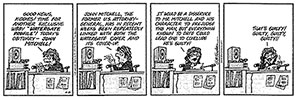
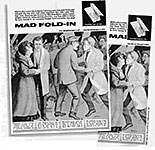

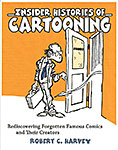
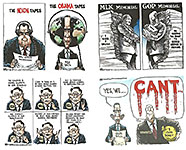
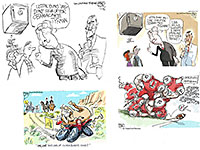
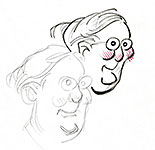

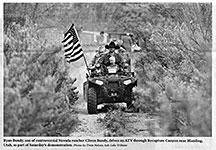
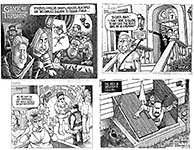

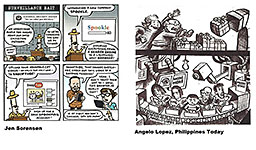
1.jpg)
2.jpg)
3.jpg)
4.jpg)

5.jpg)
6.jpg)
7.jpg)
8.jpg)
9.jpg)
10.jpg)
11.jpg)
12.jpg)
13.jpg)

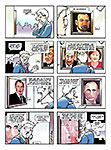
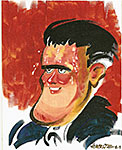
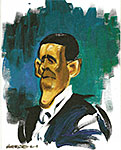

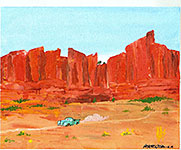


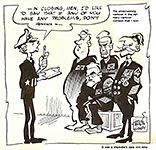
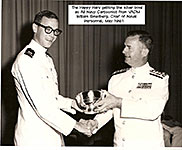
1.jpg)
2.jpg)
3.jpg)
4.jpg)
